The Mazenod–Sue–Dianne IOCG District of the Great Bear Magmatic Zone Northwest Territories, Canada
Abstract
1. Introduction
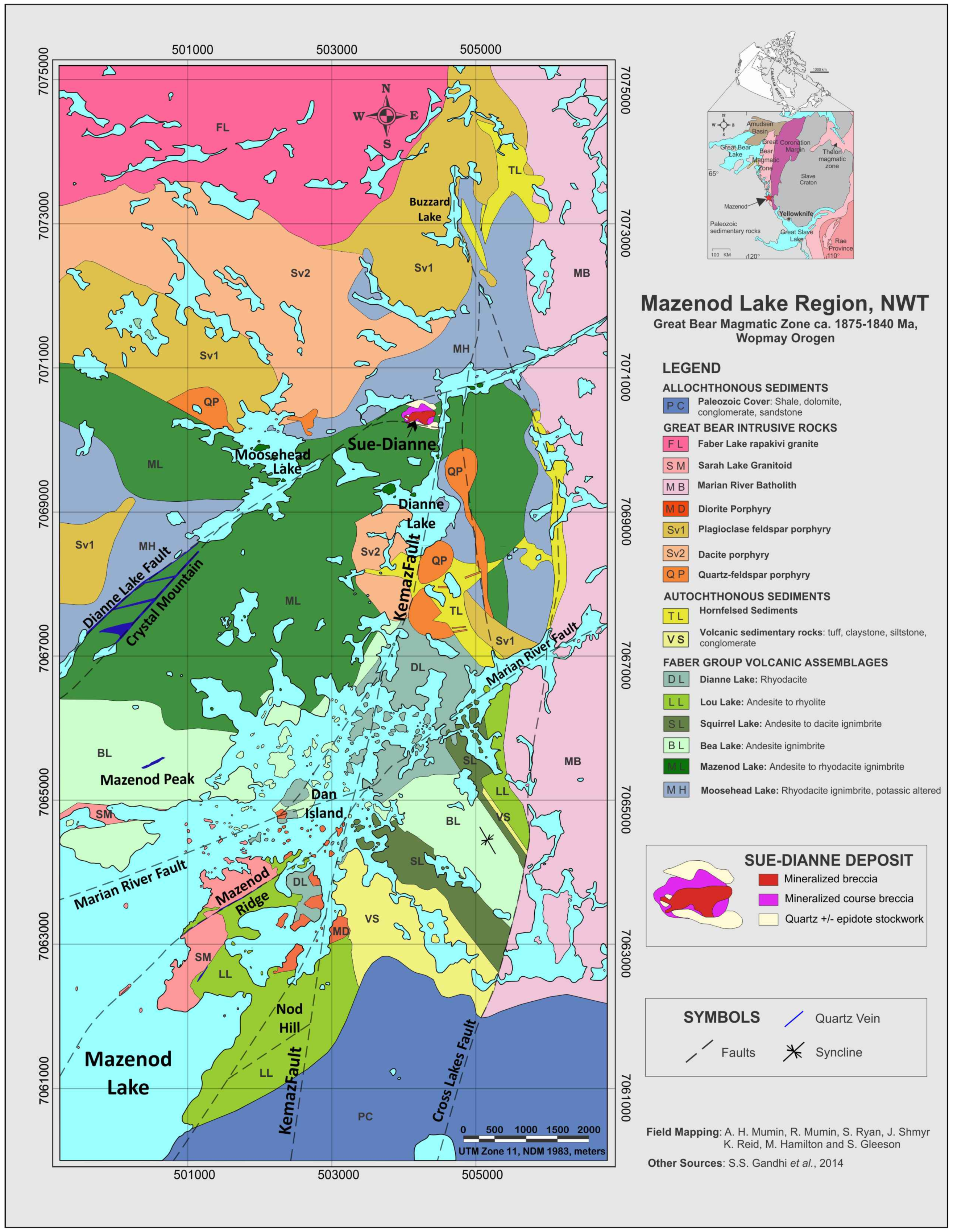
2. Great Bear Magmatic Zone
3. Geology of the Mazenod Lake Region
3.1. The Faber Lake Rapikivi Granite
3.2. The Marion River Batholith
3.3. The Sarah Lake Granite
3.4. Subvolcanic Intrusions
3.5. Faber Group Volcanic Rocks
3.6. Mazenod Lake Assemblage
3.7. Lou Lake Assemblage
3.8. Dianne Lake Assemblage
3.9. Moosehead Lake Assemblage
3.10. Squirrel Lake Assemblage
3.11. Bea Lake Assemblage
4. Hydrothermal Alteration
4.1. Chemical Characterization of Alteration
4.2. Mass Balance and Chemical Alteration
4.3. Potassic Alteration
4.4. Sodic Alteration
4.5. Magnetite and Magnetite–Actinolite
4.6. Hematite Alteration
4.7. Tourmaline Alteration
4.8. Phyllic Alteration
4.9. Epidote Alteration
4.10. Silicification
4.11. Calcic Alteration
4.12. Skarn
5. Structural Analysis of the Mazenod Lake Region
6. Sue–Dianne Deposit
7. Discussion
Author Contributions
Funding
Data Availability Statement
Acknowledgments
Conflicts of Interest
References
- Corriveau, L.; Potter, E.G. Advancing exploration for iron oxide-copper-gold and affiliated deposits in Canada: Context, scientific overview, outcomes and impacts. In Canada’s Northern Shield: New Perspectives from the Geo-Mapping for Energy and Minerals Program; Pehrsson, S., Wodicka, N., Rogers, N., Percival, J., Eds.; Geological Survey of Canada: Ottawa, ON, Canada, 2024; Bulletin 612; p. 612, in press. [Google Scholar]
- Goad, R.E.; Mumin, A.H.; Duke, N.A.; Neale, K.L.; Mulligan, D.L.; Camier, J.W. The NICO and Sue-Dianne Proterozoic, iron oxide-hosted, polymetallic deposits, Northwest Territories; application of the Olympic Dam model in exploration. Explor. Min. Geol. 2000, 9, 123–140. [Google Scholar] [CrossRef]
- Goad, R.E.; Mumin, A.H.; Duke, N.A.; Neale, K.L.; Mulligan, D.L. Geology of the Proterozoic iron oxide-hosted NICO cobalt-gold-bismuth, and Sue-Dianne copper-silver deposits, southern Great Bear Magmatic Zone, Northwest Territories, Canada. In Hydrothermal Iron Oxide Copper-Gold and Related Deposits: A Global Perspective, v. 1; Porter, T.M., Ed.; PGC Publishing: Adelaide, Australia, 2000; Volume 1, pp. 249–267. [Google Scholar]
- Mumin, A.H.; Somarin, A.; Jones, B.; Corriveau, L.; Ootes, L.; Camier, J. The IOCG-Porphyry-Epithermal Continuum in the Great Bear Magmatic Zone, Northwest Territories, Canada: Exploring for Iron Oxide Copper-Gold Deposits: Canada and Global Analogues; Geological Association of Canada: St. John’s, NL, Canada, 2010; pp. 59–78. [Google Scholar]
- Richards, J.P.; Mumin, A.H. Magmatic-hydrothermal processes within an evolving Earth: Iron oxide-copper-gold and porphyry Cu±Mo±Au deposits. Geology 2013, 41, 767–770. [Google Scholar] [CrossRef]
- Richards, J.P.; Mumin, A.H. Lithospheric fertilization and mineralization by arc magmas: Genetic links and secular differences between porphyry copper ± molybdenum ± gold and magmatic-hydrothermal iron oxide copper-gold deposits. Soc. Econ. Geol. Spec. Publ. 2013, 17, 277–299. [Google Scholar]
- Williams, P.J. Classifying IOCG Deposits: Exploring for Iron Oxide Copper–Gold Deposits: Canada and Global Analogues; Geological Association of Canada: St. John’s, NL, Canada, 2010; pp. 11–19. [Google Scholar]
- Acosta-Góngora, P.; Gleeson, S.; Samson, I.; Corriveau, L.; Ootes, L.; Taylor, B.E.; Creaser, R.A.; Muehlenbachs, K. Genesis of the Paleoproterozoic NICO iron-oxide-cobalt-gold-bismuth deposit, Northwest Territories, Canada: Evidence from isotope geochemistry and fluid inclusions. Precambrian Res. 2015, 268, 168–193. [Google Scholar] [CrossRef]
- Corriveau, L.; Mumin, A.H.; Setterfield, T. IOCG Environments in Canada: Characteristics, Geological Vectors to Ore and Challenges. In Hydrothermal Iron Oxide Copper-Gold and Related Deposits: A Global Perspective, v. 4.; Porter, T.M., Ed.; PGC Publishing: Adelaide, Australia, 2010; pp. 311–344. [Google Scholar]
- Corriveau, L.; Montreuil, J.-F.; Potter, E.G. Alteration facies linkages among IOCG, IOA and affiliated deposits in the Great Bear magmatic zone, Canada. In Proterozoic Iron Oxide-Apatite (±REE) and Iron Oxide-Copper-Gold and Affiliated Deposits of Southeast Missouri, USA, and the Great Bear Magmatic Zone, Northwest Territories, Canada; Slack, J., Corriveau, L., Hitzman, M., Eds.; Economic Geology: Littleton, CO, USA, 2016; Volume 111, pp. 2045–2072. [Google Scholar]
- Corriveau, L.; Montreuil, J.-F.; Blein, O.; Ehrig, K.; Potter, E.G.; Fabris, A.; Clark, J. Mineral systems with IOCG and affiliated deposits: Part 2—geochemical footprints. In Mineral Systems with Iron Oxide Copper-Gold (IOCG) and Affiliated Deposits; Corriveau, L., Potter, E.G., Mumin, A.H., Eds.; Geological Association of Canada: St. John’s, NL, Canada, 2022; pp. 159–204. [Google Scholar]
- Corriveau, L.; Montreuil, J.-F.; Potter, E.G.; Ehrig, K.; Clark, J.; Mumin, A.H.; Williams, P.J. Mineral systems with IOCG and affiliated deposits: Part 1–metasomatic footprints of alteration facies. In Mineral Systems with Iron Oxide Copper-Gold (IOCG) and Affiliated Deposits; Corriveau, L., Potter, E.G., Mumin, A.H., Eds.; Geological Association of Canada: St. John’s, NL, Canada, 2022; pp. 113–158. [Google Scholar]
- Hildebrand, R.S. Kiruna-type deposits: Their origin and relationship to intermediate subvolcanic plutons in the Great Bear Magmatic Zone, northwest Canada. Econ. Geol. 1986, 81, 640–659. [Google Scholar] [CrossRef]
- Montreuil, J.-F.; Corriveau, L.; Davis, W. Tectonomagmatic evolution of the southern Great Bear magmatic zone (Northwest Territories, Canada)–Implications on the genesis of iron oxide alkali-altered hydrothermal systems. In Proterozoic Iron Oxide-Apatite (±REE) and Iron Oxide-Copper-Gold and Affiliated Deposits of Southeast Missouri, USA, and the Great Bear Magmatic Zone, Northwest Territories, Canada; Slack, J., Corriveau, L., Hitzman, M., Eds.; Economic Geology: Littleton, CO, USA, 2016; Volume 111, pp. 2111–2138. [Google Scholar]
- Montreuil, J.-F.; Corriveau, L.; Potter, E.G.; De Toni, A.F. On the relation between alteration facies and metal endowment of iron oxide–alkali-altered systems, southern Great Bear magmatic zone (Canada). In Proterozoic Iron Oxide-Apatite (± REE) and Iron Oxide-Copper-Gold and Affiliated Deposits of Southeast Missouri, USA, and the Great Bear Magmatic Zone, Northwest Territories, Canada; Slack, J., Corriveau, L., Hitzman, M., Eds.; Economic Geology: Littleton, CO, USA, 2016; Volume 111, pp. 2139–2168. [Google Scholar]
- Montreuil, J.-F.; Potter, E.; Corriveau, L.; Davis, W.J. Element mobility patterns in magnetite-group IOCG systems: The Fab IOCG system, Northwest Territories, Canada. Ore Geol. Rev. 2016, 72, 562–584. [Google Scholar] [CrossRef]
- Montreuil, J.-F. Mobilité des Éléments et Formation de Gîtes Polymétalliques au sein des Systèmes à Oxydes de fer et Altération en Éléments Alcalins, Zone Magmatique du Grand lac de l’Ours, Territoires du Nord-Ouest. Ph.D. Thesis, Université du Québec, Institut National de la Recherche Scientifique, Quebec City, QC, Canada, 2016; 580p. Available online: https://espace.inrs.ca/id/eprint/3347/ (accessed on 8 April 2025).
- Mumin, A.H.; Corriveau, L.; Somarin, A.; Ootes, L. Iron oxide copper-gold-type polymetallic mineralization in the Contact Lake belt, Great Bear magmatic zone, Northwest Territories, Canada. Explor. Min. Geol. 2007, 16, 187–208. [Google Scholar] [CrossRef]
- Mumin, A.H. Echo Bay IOCG Thematic Map Series: Geology, Structure and Hydrothermal Alteration of a Stratovolcano Complex, Northwest Territories, Canada; Mumin, A.H., Ed.; Geological Survey of Canada: Ottawa, ON, Canada, 2015; Open File 7807; p. 19. [Google Scholar]
- Potter, E.G.; Montreuil, J.-F.; Corriveau, L.; Davis, W.J. The Southern Breccia metasomatic uranium system of the Great Bear magmatic zone, Canada: Iron oxide-copper-gold (IOCG) and albitite-hosted uranium linkages. In Ore Deposits: Origin, Exploration, and Exploitation: Geophysical Monograph 242, 1st ed.; Decrée, S., Robb, L., Eds.; John Wiley and Sons Inc.: Hoboken, NJ, USA, 2019; pp. 109–132. [Google Scholar]
- Potter, E.G.; Acosta-Gongora, P.; Corriveau, L.; Montreuil, J.-F.; Zhaoping, Y. Uranium Enrichment processes in metasomatic iron oxide copper-gold and iron oxide-apatite deposits. In Mineral Systems with Iron Oxide Copper-Gold (IOCG) and Affiliated Deposits; Corriveau, L., Potter, E.G., Mumin, A.H., Eds.; Geological Association of Canada: St. John’s, NL, Canada, 2022; pp. 325–346. [Google Scholar]
- Camier, J. The Sue-Dianne Proterozoic Fe-Oxide Cu-Ag-Au Breccia Complex. Master’s Thesis, University of Western Ontario, London, ON, Canada, 2002; p. 210. [Google Scholar]
- Gandhi, S.S. Report on the Geological and Mineral Occurrence Map of the Mazenod Lake-Lou Lake Area, Northwest Territories; Geological Survey of Canada: Ottawa, ON, Canada, 2013; Open File 7546; 44p. [Google Scholar]
- Gandhi, S.S.; Montreuil, J.-F.; Corriveau, L. Geology and Mineral Occurrences, Mazenod Lake-Lou Lake Area, Northwest Territories, Geological Survey of Canada, Canadian Geoscience Map 148 (Preliminary); Northwest Territories Geoscience Office: Yellowknife, NT, Canada, 2014; Open Report 2013-004, scale 1:50000. [Google Scholar]
- Hamilton, M.S. Geology, Structure and Geochemistry of the Mazenod Lake Volcanic Complex. Master’s Thesis, Brandon University, Brandon, MB, Canada, 2017; p. 232. [Google Scholar]
- Hayward, N.; Tschirhart, V. Geophysical Series, Regional Geophysical Compilation Project, Great Bear Magmatic Zone, Northwest Territories and Nunavut, NTS 85 M and N, and 86 C, D, E, F, K and L; Geological Survey of Canada: St. John’s, NL, Canada, 2022; Open File 6835, 2 sheets. [Google Scholar] [CrossRef]
- Hetu, R.J.; Homan, P.B.; Charbonneau, B.W.; Prasad, N.; Gandhi, S.S. Airborne Geophysical Survey, Mazenod Lake, NWT; Geological Survey of Canada: St. John’s, NL, Canada, 1994; Open file 2806. [Google Scholar] [CrossRef]
- Hildebrand, R.S.; Hoffman, P.F.; Bowring, S.A. Tectono-magmatic evolution of the 1.9-Ga Great Bear magmatic zone, Wopmay Orogen, northwestern Canada. J. Volcanol. Geotherm. Res. 1987, 32, 99–118. [Google Scholar] [CrossRef]
- Hoffman, P.F.; Hall, L. Geology, Slave Craton and Environs, District of Mackenzie, Northwest Territories; Geological Survey of Canada: Ottawa, ON, Canada, 1993; Open File 2559, 1 sheet. [Google Scholar]
- Jackson, V.A.; van Breemen, O.; Ootes, L.; Bleeker, W.; Bennett, V.; Davis, W.D.; Ketchum, J.; Smar, L. Ages of basement and intrusive phases East of the Wopmay fault zone, south-central Wopmay Orogen, NWT: A field-based U–Pb zircon study. Can. J. Earth Sci. 2013, 50, 979–1006. [Google Scholar] [CrossRef]
- Bowring, S.A. U-Pb Zircon Geochronology of Early Proterozoic Wopmay Orogen, NWT Canada: An Example of Rapid Crustal Evolution. Ph.D. Thesis, Kansas University, Lawrence, MA, USA, 1985. [Google Scholar]
- Bowring, S.A.; Grotzinger, J.P. Implications of new chronostratigraphy for tectonic evolution of Wopmay Orogen, northwest Canadian Shield. Am. J. Sci. 1992, 292, 1–20. [Google Scholar] [CrossRef]
- Bowring, S.A.; Podosek, F.A. Nd isotopic evidence from Wopmay orogen for 2.0–2.4 Ga crust in western North America. Earth Planet. Sci. Lett. 1989, 94, 217–230. [Google Scholar] [CrossRef]
- Davis, W.J.; Ootes, L.; Newton, L.; Jackson, V.A.; Stern, R.A. Characterization of the Paleoproterozoic Hottah terrane, Wopmay Orogen using multiisotopic (U–Pb, Hf and O) detrital zircon analyses: An evaluation of linkages to northwest Laurentian Paleoproterozoic domains. Precambrian Res. 2015, 269, 296–310. [Google Scholar] [CrossRef]
- Gandhi, S.S.; Breemen, O.V. SHRIMP U-Pb geochronology of detrital zircons from the Treasure Lake Group new evidence for Paleoproterozoic collisional tectonics in the southern Hottah terrane, northwestern Canadian Shield. Can. J. Earth Sci. 2005, 42, 833–845. [Google Scholar] [CrossRef]
- Gandhi, S.S.; Mortensen, J.; Prasad, N.; Breemen, O.V. Magmatic evolution of the southern Great Bear continental arc, northwestern Canadian Shield: Geochronological constraints. Can. J. Earth Sci. 2011, 38, 767–785. [Google Scholar] [CrossRef]
- Housh, T.; Bowring, S.A.; Villeneuve, M. Lead isotopic study of early Proterozoic Wopmay Orogen, NW Canada: Role of continental crust in arc magmatism. J. Geol. 1989, 97, 735–747. [Google Scholar] [CrossRef]
- Jackson, V.A.; Ootes, L. Preliminary geologic map of the south-central Wopmay Orogen (parts of NTS 86B, 86C, and 86D). In Results from 2009 to 2011: NWT Open Report 2012-004, 1 Map, 1:100,000 Scale; NWT Geoscience Office: Yellowknife, NT, Canada, 2012. [Google Scholar]
- Ootes, L.; Davis, W.J.; Jackson, V.A.; van Breemen, O.; Corfu, F. Chronostratigraphy of the Hottah terrane and Great Bear magmatic zone of Wopmay Orogen, Canada, and exploration of a terrane translation model. Can. J. Earth Sci. 2015, 52, 1062–1092. [Google Scholar] [CrossRef]
- Bennett, V.; Rivers, T. U-Pb Ages of Zircon Primary Crystallization and Inheritance for Magmatic Rocks of the Southern Wopmay Orogen, Northwest Territories; Northwest Territories Geoscience Office: Yellowknife, NT, Canada, 2006; NWT Open Report 2006; 64p. [Google Scholar]
- Mumin, A.H.; Phillips, A.; Katsuragi, C.J.; Mumin, A.; Ivanov, G. Geotectonic Interpretation of the Echo Bay Stratovolcano Complex, Northern Great Bear Magmatic Zone, NWT, Canada; Northwest Territories Geoscience Office, NWT: Yellowknife, NT, Canada, 2014; p. 25. [Google Scholar]
- Davis, W.J.; Corriveau, L.; van Breemen, O.; Bleeker, W.; Montreuil, J.-F.; Potter, E.; Pelleter, E. Timing of IOCG mineralising and alteration events within the Great Bear magmatic zone [abs.]. In Proceedings of the 39th Annual Yellowknife Geoscience Forum Abstracts, Yellowknife, NT, Canada, 15–17 November 2011; Fischer, B.J., Watson, D.M., Eds.; Northwest Territories Geoscience Office: Yellowknife, NT, Canada, 2011; Volume 2011, p. 97. [Google Scholar]
- Hayward, N.; Corriveau, L. Fault reconstructions using aeromagnetic data in the Great Bear magmatic zone, Northwest Territories, Canada. Can. J. Earth Sci. 2014, 51, 927–942. [Google Scholar] [CrossRef]
- Hildebrand, R.S.; Hoffman, P.F.; Bowring, S.A. The Calderian orogeny in Wopmay orogen (1.9 Ga), northwestern Canadian Shield. Geol. Soc. Am. Bull. 2010, 122, 794–814. [Google Scholar] [CrossRef]
- Ootes, L.; Snyder, D.; Davis, W.J.; Acosta-Góngora, P.; Corriveau, L.; Mumin, A.H.; Gleeson, S.A.; Samson, I.A.; Montreuil, J.-F.; Potter, E.; et al. A Paleoproterozoic Andean-type iron oxide copper-gold environment, the Great Bear magmatic zone, Northwest Canada. Ore Geol. Rev. 2017, 81, 123–139. [Google Scholar] [CrossRef]
- Gandhi, S.S.; Mortensen, J.K.; Prasad, N.; van Breeman, O. U-Pb geochronology of the southern Great Bear magmatic zone and its implications to the metallogenic evolution. Extended abstract. In Proceedings of the Yellowknife Geoscience Forum, Yellowknife, NT, Canada, 25–27 November 1998. [Google Scholar]
- Corriveau, L.; Montreuil, J.-F.; De Toni, A.F.; Potter, E.G.; Percival, J.B. Mapping mineral systems with IOCG and affiliated deposits: A facies approach. In Mineral Systems with Iron Oxide Copper-Gold (IOCG) and Affiliated Deposits; Corriveau, L., Potter, E.G., Mumin, A.H., Eds.; Geological Association of Canada: St. John’s, NL, Canada, 2022; pp. 69–111. [Google Scholar]
- Corriveau, L.; Montreuil, J.-F.; Potter, E.G.; Blein, O.; De Toni, A.F. Mineral systems with IOCG and affiliated deposits: Part 3–metal pathways and ore deposit model. In Mineral Systems with Iron Oxide Copper-Gold (IOCG) and Affiliated Deposits; Corriveau, L., Potter, E.G., Mumin, A.H., Eds.; Geological Association of Canada: St. John’s, NL, Canada, 2022; pp. 205–245. [Google Scholar]
- Bennett, V.; Rivers, T. U-Pb Ages of Detrital Zircons from the Southern Wopmay Orogen, Northwest Territories; Northwest Territories Geoscience Office: Yellowknife, NT, Canada, 2006; NWT Open Report 2006; 29p. [Google Scholar]
- Bennett, V.; Rivers, T.; Jackson, V. A Compilation of U-Pb Zircon Preliminary Crystallization and Depositional Ages from the Paleoproterozoic Southern Wopmay Orogen, Northwest Territories; NWT Geoscience Office: Yellowknife, NT, Canada, 2012; NWT Open Report 2012; 172p. [Google Scholar]
- Montreuil, J.-F.; Corriveau, L.; Potter, E.G. Formation of albitite-hosted uranium within IOCG systems: The Southern Breccia, Great Bear magmatic zone, Northwest Territories, Canada. Miner. Depos. 2015, 50, 293–325. [Google Scholar] [CrossRef]
- Pearce, J.A.; Harris, N.B.W.; Tindle, A.G. Trace element discrimination diagrams for the tectonic interpretation of granitic rocks. J. Petrol. 1984, 25, 956–983. [Google Scholar] [CrossRef]
- Corriveau, L.; Williams, P.J.; Mumin, H. Alteration Vectors to IOCG Mineralization–from Uncharted Terranes to Deposits. In Exploring for Iron Oxide Copper-Gold Deposits: Canada and Global Analogues; Corriveau, L., Mumin, A.H., Eds.; Geological Association of Canada: St. John’s, NL, Canada, 2010; Add SCN 20; pp. 89–110. [Google Scholar]
- Pearce, J.A. A User’s Guide to Basalt Discrimination Diagrams: Trace Element Geochemistry of Volcanic Rocks: Applications for Massive Sulphide Exploration; Geological Association of Canada: St. John’s, NL, Canada, 1996; Volume 12, 113p. [Google Scholar]
- Corriveau, L.; Lauzière, K.; Montreuil, J.-F.; Potter, E.G.; Hanes, R.; Prémont, S. Dataset of Geochemical Data from Iron Oxide Alkali-Altered Mineralizing Systems of the Great Bear Magmatic Zone (NWT); Geological Survey of Canada: Ottawa, ON, USA, 2015; p. 19. [Google Scholar]
- Corriveau, L.; Mumin, A.H.; Potter, E.G. Iron oxide copper-gold (Ag-Bi-Co-U-REE) and affiliated deposits: Introduction and overview. In Mineral Systems with Iron Oxide Copper-Gold (IOCG) and Affiliated Deposits; Corriveau, L., Potter, E.G., Mumin, A.H., Eds.; Geological Association of Canada: St. John’s, NL, Canada, 2022; pp. 1–25. [Google Scholar]
- Montreuil, J.-F.; Corriveau, L.; Grunsky, E.C. Compositional data analysis of IOCG systems, Great Bear magmatic zone, Canada: To each alteration type its own geochemical signature: Geochemistry. Explor. Environ. Anal. 2013, 13, 229–247. [Google Scholar] [CrossRef]
- Baker, T. Alteration, mineralization, and fluid evolution at the Eloise Cu-Au deposit, Cloncurry District, northwest Queensland, Australia. Econ. Geol. 1998, 93, 1213–1236. [Google Scholar] [CrossRef]
- De Toni, A.F. Les Paragénèses à Magnétite des Altérations Associées aux Systèmes à Oxydes de fer et Altérations en Éléments Alcalins, Zone Magmatique du Grand lac de l’Ours. Master’s Thesis, Institut national de la Recherche Scientifique, Québec City, QC, Canada, 2016; 534p. [Google Scholar]
- Fabris, A. Geochemical characteristics of IOCG deposits: Examples from the Olympic Copper-Gold Province, South Australia. In Mineral Systems with Iron Oxide Copper-Gold (IOCG) and Affiliated Deposits; Corriveau, L., Potter, E.G., Mumin, A.H., Eds.; Geological Association of Canada: St. John’s, NL, Canada, 2022; pp. 247–262. [Google Scholar]
- Groves, D.I.; Bierlein, F.P.; Meinert, L.D.; Hitzman, M. Iron oxide copper-gold (IOCG) deposits through Earth history: Implications for origin, lithospheric setting, and distinction from other epigenetic iron oxide deposits. Econ. Geol. 2010, 105, 641–654. [Google Scholar] [CrossRef]
- Hildebrand, R.S.; Bowring, S. Geology of parts of the Calder River map area, central Wopmay orogen, District of Mackenzie. Curr. Res. Part C Geol. Surv. Can. 1988, 199–205. [Google Scholar]
- Hitzman, M.W. Iron oxide Cu-Au deposits: What, where, when, and why? In Hydrothermal Iron Oxide Copper-Gold & Related Deposits: A Global Perspective; Porter, T.M., Ed.; Australian Mineral Foundation: Adelaide, Australia, 2000; Volume 1, pp. 201–218. [Google Scholar]
- Hitzman, M.W.; Oreskes, N.; Einaudi, M.T. Geological characteristics and tectonic setting of Proterozoic iron oxide (Cu-U-Au-REE) deposits. Precambrian Res. 1992, 58, 241–287. [Google Scholar] [CrossRef]
- Kelly, C.J.; Davis, W.J.; Potter, E.G.; Corriveau, L. Geochemistry of hydrothermal tourmaline from IOCG occurrences in the Great Bear magmatic zone: Implications for fluid source(s) and fluid composition evolution. Ore Geol. Rev. 2020, 118, 103329. [Google Scholar] [CrossRef]
- Montreuil, J.F.; Corriveau, L.; Blein, O.; Ehrig, K.; Hofstra, A.; Lisitsin, V.; Belperio, A.; Schlegel, T.; Mansur, E.; Conliffe, J.; et al. Distribution of alteration facies, deposit types, metals, and critical minerals in metasomatic iron and alkali-calcic (MIAC) mineral systems: Geological Association of Northern Shield: New Perspectives from the Geo-Mapping for Energy and Minerals Meeting. Abstracts 2022, 45, 160–161. [Google Scholar]
- Mumin, H.; Richards, J.P. Subduction-modified lithosphere as a source for a spectrum of distal-to post-subduction magmatic-hydrothermal Cu-Au-Mo-Fe deposits. In Porphyries to IOCGs, Geological Society of America, Charlotte, North Carolina, 2012, Annual Meeting, Abstracts with Programs, Paper no. 213-6. 2012. Available online: https://gsa.confex.com/gsa/2012AM/webprogram/Paper205374.html (accessed on 8 April 2025).
- Porter, T.M. Hydrothermal Iron Oxide Copper-Gold and Related Deposits: A Global Perspective; Australian Mineral Foundation: Adelaide, Australia, 2000; p. 349. [Google Scholar]
- Sillitoe, R.H. Iron oxide-copper-gold deposits: An Andean view. Miner. Depos. 2003, 38, 787–812. [Google Scholar] [CrossRef]
- Skirrow, R. “Hematite-group” IOCG ± U ore systems: Tectonic settings, hydrothermal characteristics, and Cu-Au and U mineralizing processes. In Exploring for Iron Oxide Copper-Gold Deposits: Canada and Global Analogues; Corriveau, L., Mumin, A.H., Eds.; Geological Association of Canada: St. John’s, NL, Canada, 2010; pp. 39–57. [Google Scholar]
- Skirrow, R.G. Iron oxide copper-gold (IOCG) deposits–A review (part 1): Settings, mineralogy, ore geochemistry and classification. Ore Geol. Rev. 2022, 140, 104569. [Google Scholar] [CrossRef]
- Skirrow, R.G. Hematite-group IOCG ± U deposits: An update on their tectonic settings, hydrothermal characteristics, and Cu-Au-U mineralizing processes. In Mineral Systems with Iron Oxide Copper-Gold (IOCG) and Affiliated Deposits; Corriveau, L., Potter, E.G., Mumin, A.H., Eds.; Geological Association of Canada: St. John’s, NL, Canada, 2022; Volume 52, pp. 27–51. [Google Scholar]
- Williams, P.J.; Barton, M.D.; Johnson, D.A.; Fontboté; L; de Haller, A.; Mark, G.; Oliver, N.H.S.; Marschik, R. Iron-Oxide Copper-Gold Deposits: Geology, Space-Time Distribution, and Possible Modes of Origin: Economic Geology 100th Anniversary; Society of Economic Geologists: Littleton, CO, USA, 2005; pp. 371–405. [Google Scholar]
- Grant, J.A. The Isocon Diagram–A simple solution to Gresens’ equation for metasomatic alteration. Econ. Geol. 1986, 81, 1976–1982. [Google Scholar] [CrossRef]
- Grant, J.A. Isocon analysis: A brief review of the method and applications. Phys. Chem. Earth Parts A/B/C 2005, 30, 97–1004. [Google Scholar] [CrossRef]
- Gresens, R.L. Composition-volume relationships in metasomatism. Chem. Geol. 1967, 2, 47–55. [Google Scholar] [CrossRef]
- Mumin, A. Tectonic and Structural Controls on Massive Sulfide Deposition in the South Sturgeon Lake Volcanic Pile, Northwestern Ontario and Hydrothermally Altered Rocks Associated with the Lyon Lake Archean Volcanogenic Massive Sulfide Ore deposits, Sturgeon Lake. Master’s Thesis, University of Toronto, Toronto, ON, Canada, 1988. [Google Scholar]
- Ishikawa, Y.; Sawaguchi, S.; Iwaya, H.M. Delineation of prospecting targets for Kuroku deposits based on modes of volcanism of underlying dacite and alteration haloes. Min. Geol. 1976, 26, 105–117. [Google Scholar]
- Acosta-Góngora, P.; Gleeson, S.; Samson, I.; Corriveau, L.; Ootes, L.; Jackson, S.E.; Taylor, B.E.; Girard, I. Origin of sulfur and crustal recycling of copper in polymetallic (Cu-Au-Co-Bi-U ± Ag) iron-oxide-dominated systems of the Great Bear magmatic zone, NWT, Canada. Miner. Depos. 2018, 53, 353–376. [Google Scholar] [CrossRef]
- Gandhi, S.S.; Halliday, D. Gravity Survey of the Sue-Dianne Deposit, Northwest Territories; Geological Survey of Canada: Ottawa, ON, Canada, 1993; p. 93-1E. [Google Scholar]
- Kreiner, D.; Barton, M.D. Sulfur-poor intense acid hydrothermal alteration: A distinctive hydrothermal environment. Ore Geol. Rev. 2017, 88, 174–187. [Google Scholar] [CrossRef]
- Gandhi, S.S.; Potter, E.G.; Fayek, M. New constraints on genesis of the polymetallic veins at Port Radium, Great Bear Lake, Northwest Canadian Shield. Ore Geol. Rev. 2018, 96, 28–47. [Google Scholar] [CrossRef]
- Somarin, A.K.; Mumin, A.H. The Paleoproterozoic high heat production Richardson granite, Great Bear magmatic zone, Northwest Territories, Canada: Source of U for Port Radium? Resour. Geol. 2012, 62, 227–242. [Google Scholar] [CrossRef]
- Hayward, N. 3D Magnetic Inversion of Mineral Prospects in the Great Bear Magmatic Zone, NT, Canada. Geological Survey of Canada: St. John’s, NL, Canada, 2013. [Google Scholar]
- Hayward, N.; Skirrow, R.G. Geodynamic setting and controls on iron oxide Cu-Au (±U) Ore in the Gawler Craton, South Australia. In Hydrothermal Iron Oxide Copper-Gold and Related Deposits: A Global Perspective-Advances in the Understanding of IOCG Deposits; Porter, T.M., Ed.; PGC Publishing: Adelaide, Australia, 2010; Volume 3, pp. 119–146. [Google Scholar]
- Hayward, N.; Corriveau, L.; Craven, J.A.; Enkin, R.J. Geophysical signature of the NICO Au-Co-Bi-Cu deposit and its iron oxide-alkali alteration system, Northwest Territories, Canada. In Proterozoic Iron Oxide-Apatite (± REE) and Iron Oxide-Copper-Gold and Affiliated Deposits of Southeast Missouri, USA, and the Great Bear Magmatic Zone, Northwest Territories, Canada; Slack, J., Corriveau, L., Hitzman, M., Eds.; Economic Geology: Littleton, CO, USA, 2016; Volume 111, pp. 2087–2110. [Google Scholar]
- Jebrak, M. Use of breccias in IOCG(U) exploration. In Exploring for Iron Oxide Copper-Gold Deposits: Canada and Global Analogues; Corriveau, L., Mumin, A.H., Eds.; Geological Association of Canada: St. John’s, NL, Canada, 2010; pp. 79–88. [Google Scholar]
- Jebrak, M. Use of breccias in IOCG exploration: An Updated Review. In Mineral Systems with Iron Oxide Copper-Gold (IOCG) and Affiliated Deposits; Corriveau, L., Potter, E.G., Mumin, A.H., Eds.; Geological Association of Canada: St. John’s, NL, Canada, 2022; pp. 315–324. [Google Scholar]
- Richards, J.P.; Lopez, G.P.; Zhu, J.; Creaser, R.A.; Locock, A.J.; Mumin, A.H. Contrasting tectonic settings and sulfur contents of magmas associated with Cretaceous porphyry Cu + Mo + Au and intrusion-related iron oxide Cu-Au deposits in northern Chile. Econ. Geol. 2017, 112, 295–318. [Google Scholar] [CrossRef]
- Hildebrand, R.S.; Bowring, S.A. Continental intra-arc depressions: A nonextensional model for their origin, with a Proterozoic example from Wopmay orogen. Geology 1984, 12, 73–77. [Google Scholar] [CrossRef]
- Hoffman, P.F. Wopmay orogen: A Wilson Cycle of early Proterozoic age in the northwest of the Canadian Shield. In The Continental Crust and Its Mineral Resources; Strangway, D.W., Ed.; Geological Association of Canada: St. John’s, NL, Canada, 1980; Volume 20, pp. 523–549. [Google Scholar]
- Hoffman, P.F.; Bowring, S.A. Short-lived 1.9 Ga continental margin and its destruction, Wopmay orogen, northwest Canada. Geology 1984, 12, 68–72. [Google Scholar] [CrossRef]
- Jara, J.J.; Barra, F.; Reich, M.; Leisen, M.; Romero, R.; Morata, D. Episodic construction of the early Andean Cordillera unravelled by zircon petrochronology. Nat. Commun. 2021, 12, 4930. [Google Scholar] [CrossRef] [PubMed]
- Seymour, N.M.; Singleton, J.S.; Mavor, S.P.; Gomila, R.; Stockli, D.F.; Heuser, G.; Arancibia, G. The relationship between magmatism and deformation along the intra-arc strike-slip Atacama fault system, northern Chile. Tectonics 2020, 39, e2019TC005702. [Google Scholar] [CrossRef]
- Tornos, F.; Hanchar, J.M.; Munizaga, R.; Velasco, F.; Galindo, C. The role of the subducting slab and melt crystallization in the formation of magnetite-(apatite) systems, Coastal Cordillera of Chile. Miner. Depos. 2021, 56, 253–278. [Google Scholar] [CrossRef]
- Hayward, N.; Tschirhart, V. A Comparison of 3-D Inversion Strategies in the Investigation of the 3-D Density and Magnetic Susceptibility Distribution in the Great Bear Magmatic Zone, Northwest Territories; Geological Survey of Canada: St. John’s, NL, Canada, 2023; Open File 8985; 18p. [Google Scholar] [CrossRef]
- Shatwell, D. Adjacent Iron Oxide-Apatite and Iron Oxide Copper-Gold Mineralization in the Acarí District, Peru. Magmat. Hydrothermal Transit. SEG Discov. 2023, 133, 19–27. [Google Scholar] [CrossRef]
- Hennessey, B.T.; Puritch, E. A Technical Report on a Mineral Resource Estimate for the Sue-Dianne Deposit, Mazenod Lake area, Northwest Territories, Canada: Fortune Minerals Limited, NI 43-101 Technical Report, 2008. 125p. Available online: www.sedar.com (accessed on 8 March 2021).
- Putnis, A.; Hinrichs, R.; Putnis, C.V.; Golla-Schindler, U.; Collins, L.G. Hematite in porous red-clouded feldspars: Evidence of large-scale crustal fluid–rock interaction. Lithos 2007, 95, 10–18. [Google Scholar] [CrossRef]
- Corriveau, L.; Ootes, L.; Mumin, H.; Jackson, V.; Bennett, V.; Cremer, J.; Rivard, B.; McMartin, I.; Beaudoin, G. Alteration vectoring to IOCG (U) deposits in frontier volcano-plutonic terrains, Canada. In Proceedings of the Exploration 07: Fifth Decennial International Conference on Mineral Exploration, Toronto, ON, Canada, 9–12 December 2007; pp. 1171–1177. [Google Scholar]
- Corriveau, L.; Mumin, A.H. Exploring for iron oxide copper–gold deposits: The need for case studies, classifications and exploration vectors. In Exploring for Iron Oxide Copper-Gold Deposits: Canada and Global Analogues; Corriveau, L., Mumin, A.H., Eds.; Geological Association of Canada: St. John’s, NL, Canada, 2010; pp. 1–12. [Google Scholar]
- Normandeau, P.X.; Harlov, D.E.; Corriveau, L.; Paquette, J.; McMartin, I. Characterization of fluorapatite within iron oxide alkali-calcic alteration systems of the Great Bear magmatic zone: A potential metasomatic process record. Can. Mineral. 2018, 56, 1–21. [Google Scholar] [CrossRef]
- Sappin, A.-A.; Dupuis, C.; Beaudoin, G.; Pozza, M.; McMartin, I.; McClenaghan, M.B. Optimal ferromagnetic fraction of iron oxides in till samples along ice-flow paths: Case studies from the Sue-Dianne and Thompson deposits, Canada. Geochem. Explor. Environ. Anal. 2014, 14, 315–329. [Google Scholar] [CrossRef]
- Shives, R.B.K.; Charbonneau, B.W.; Ford, K.L. The detection of potassic alteration by gamma-ray spectrometry–Recognition of alteration related to mineralization. Geophysics 2000, 65, 2001–2011. [Google Scholar] [CrossRef]
- Sidor, M. The Origin of Black Rock Alteration Overprinting Iron-Rich Sediments and Its Genetic Relationship to Disseminated Polymetallic Ores, Lou Lake, Northwest Territories, Canada. Unpublished Master’s Thesis, University of Western Ontario, London, ON, Canada, 2000; 243p. [Google Scholar]
- Somarin, A.K.; Mumin, A.H. P–T-composition and evolution of paleofluids in the Paleoproterozoic Mag Hill IOCG hydrothermal system, Contact Lake belt, Northwest Territories, Canada. Miner. Depos. 2014, 49, 199–215. [Google Scholar] [CrossRef]
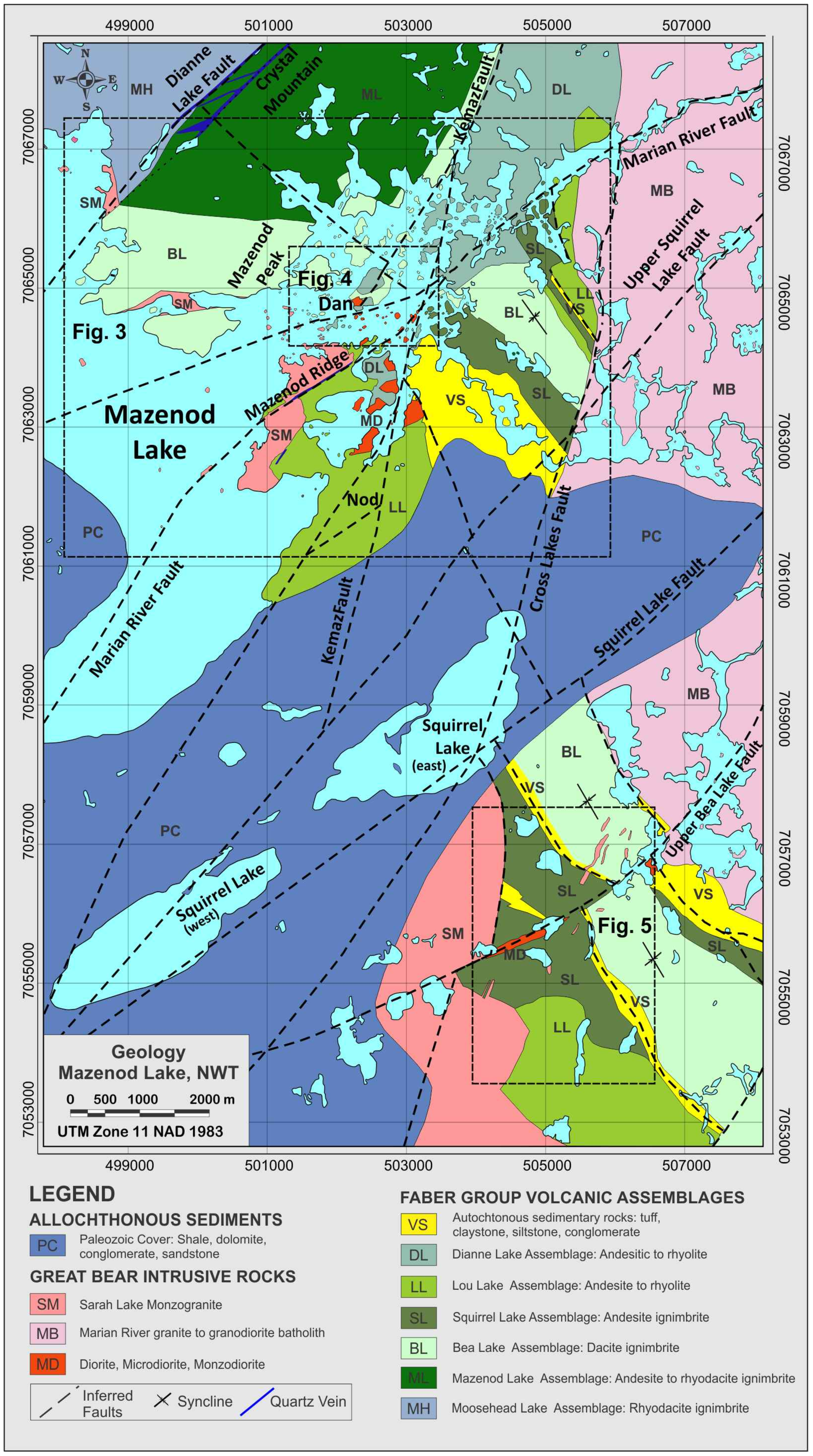

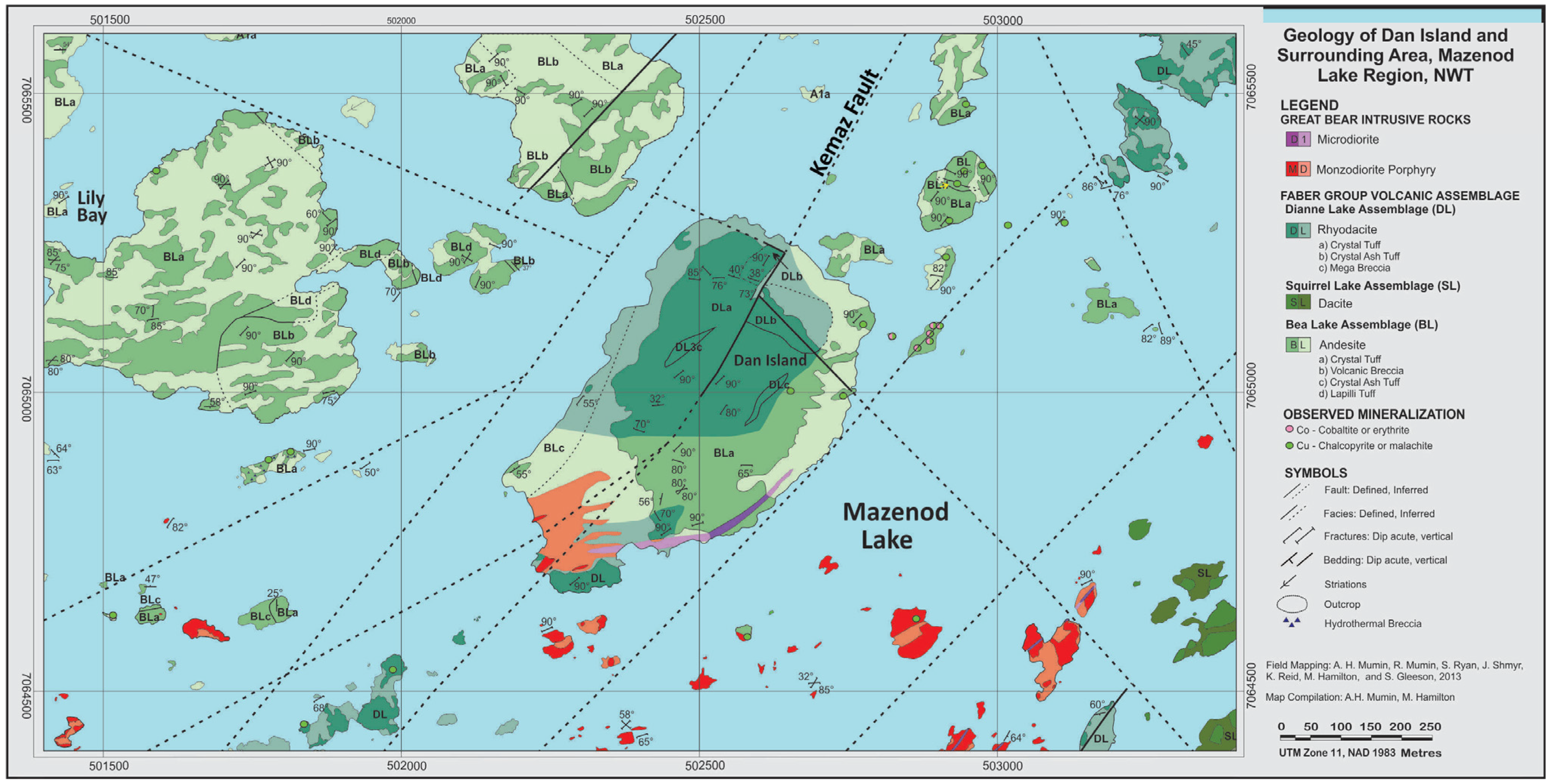
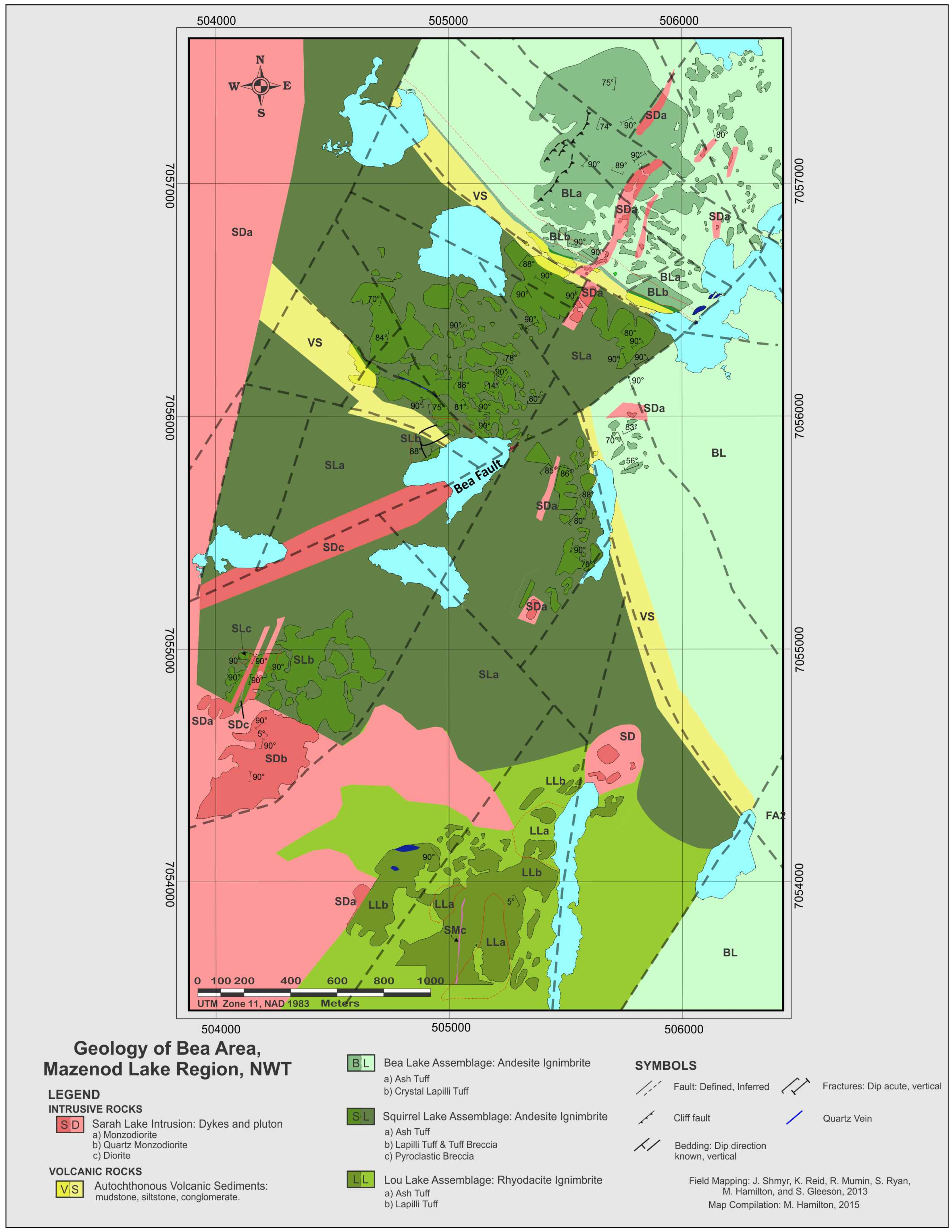

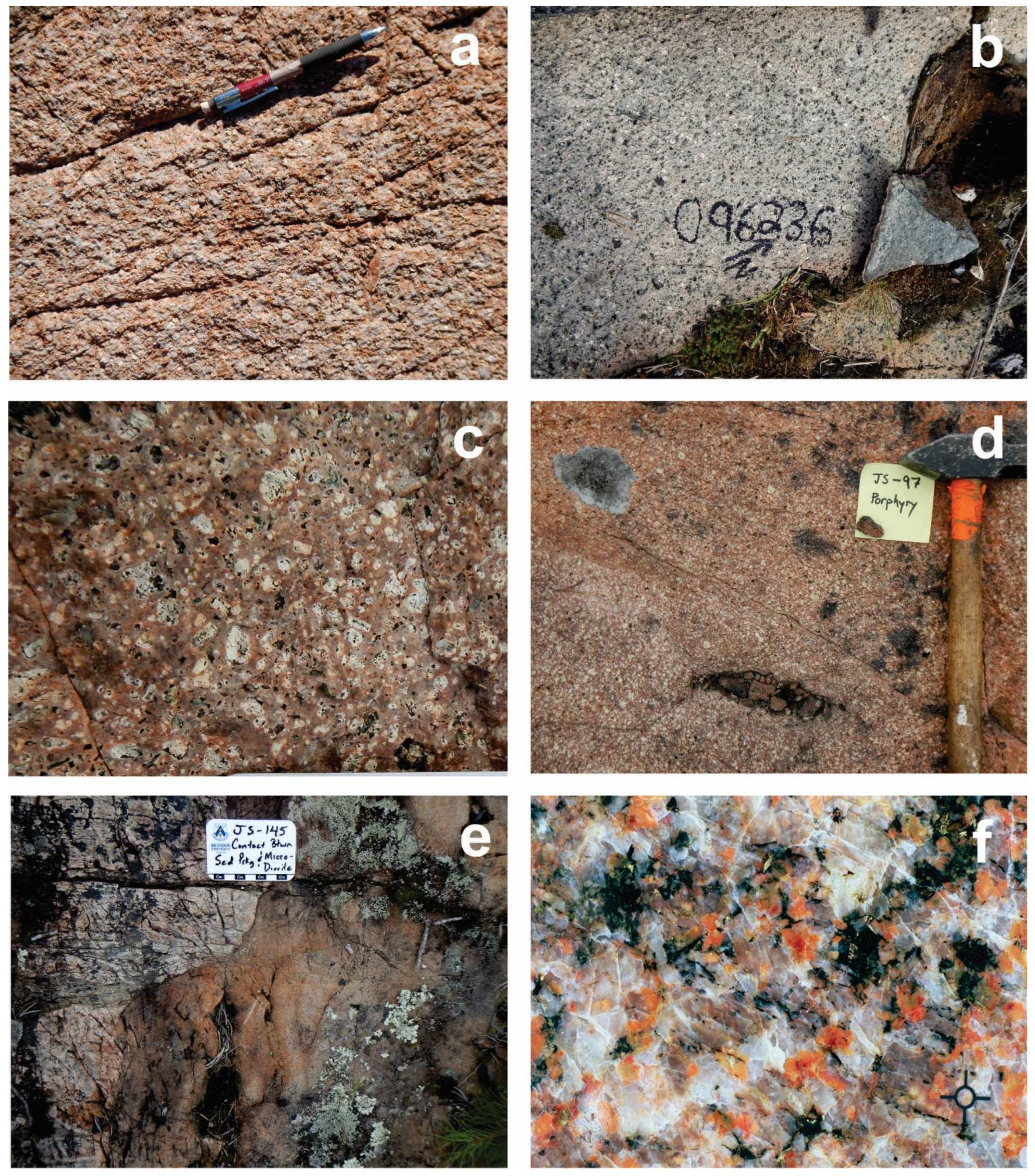

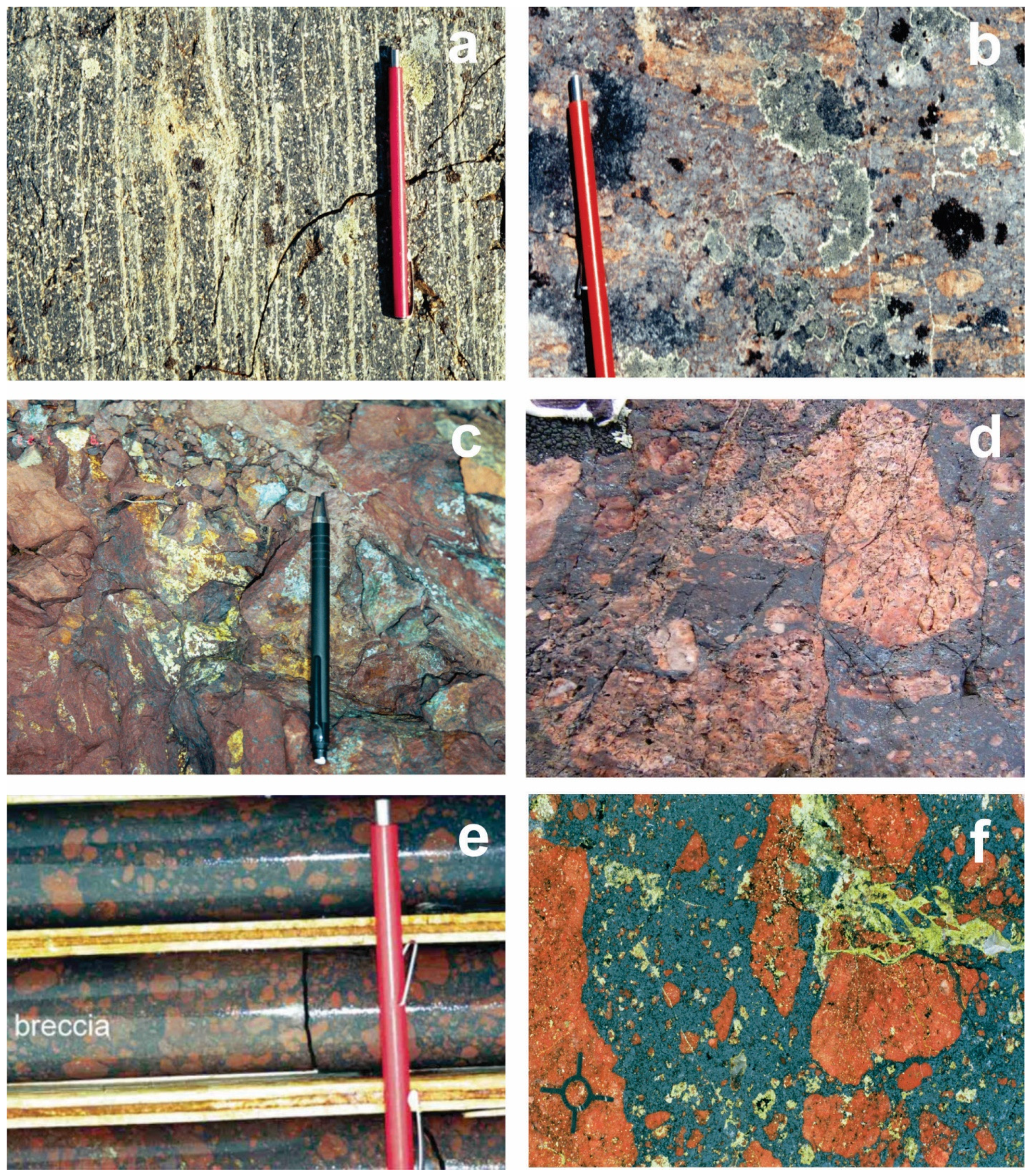

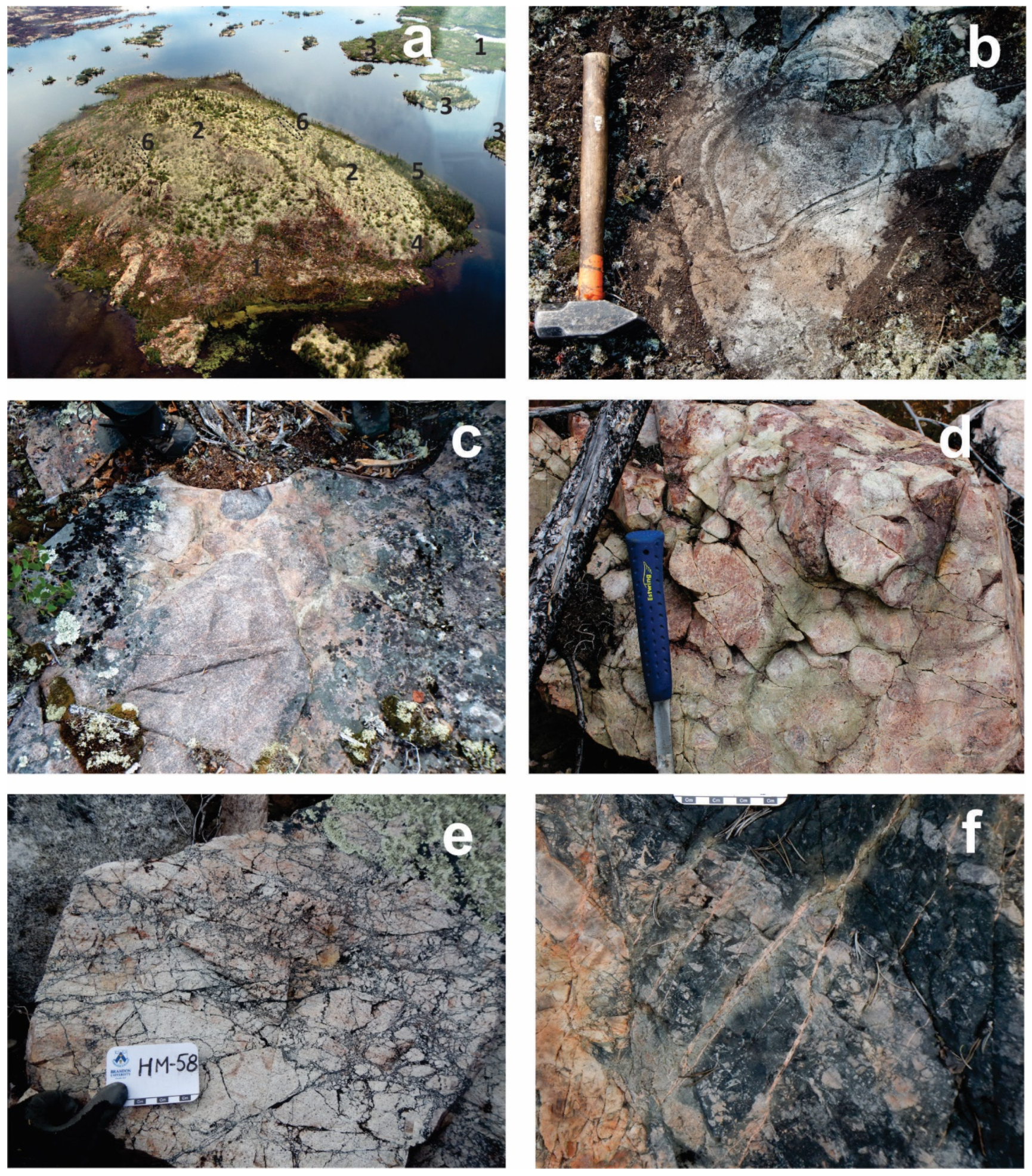
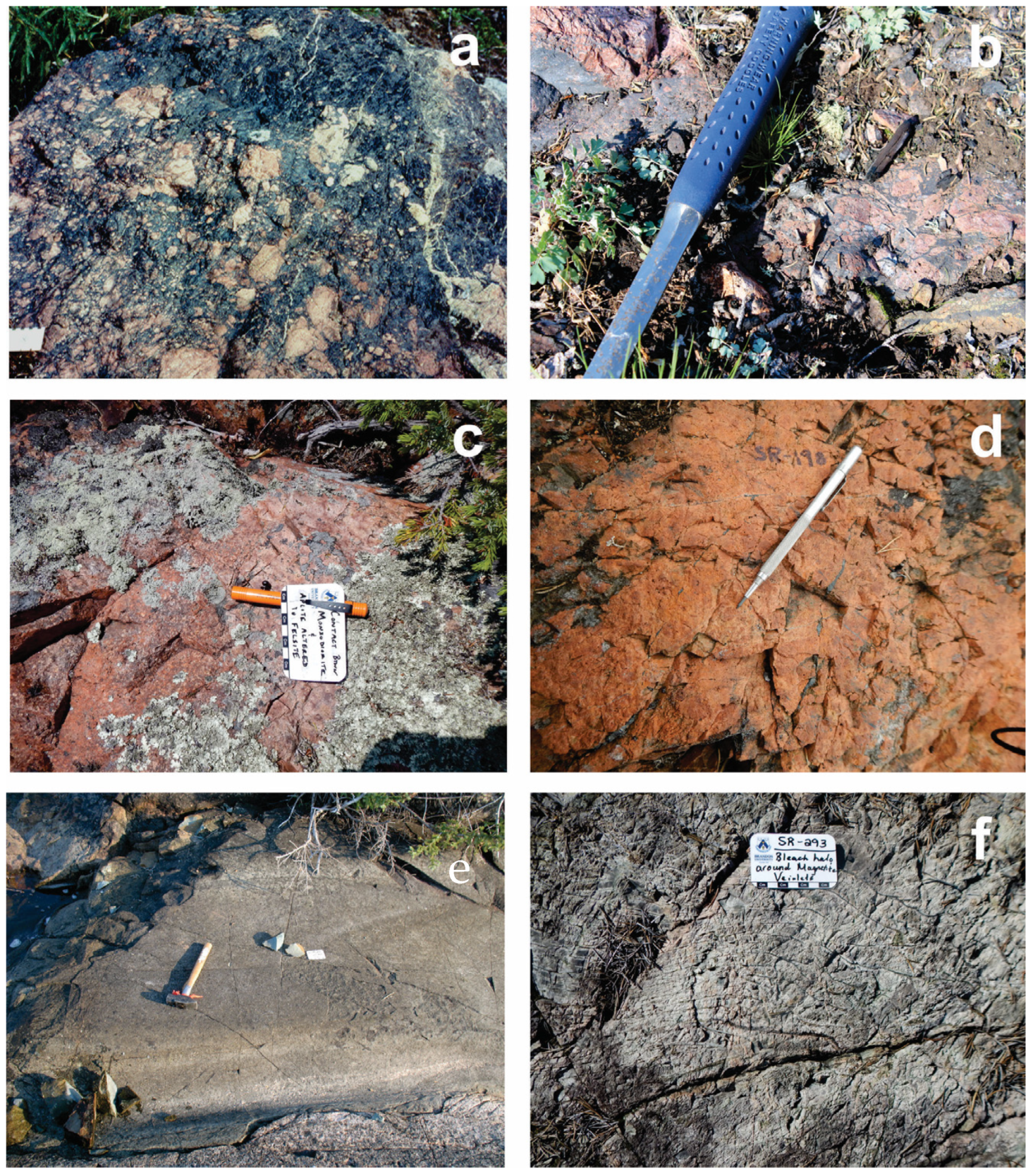
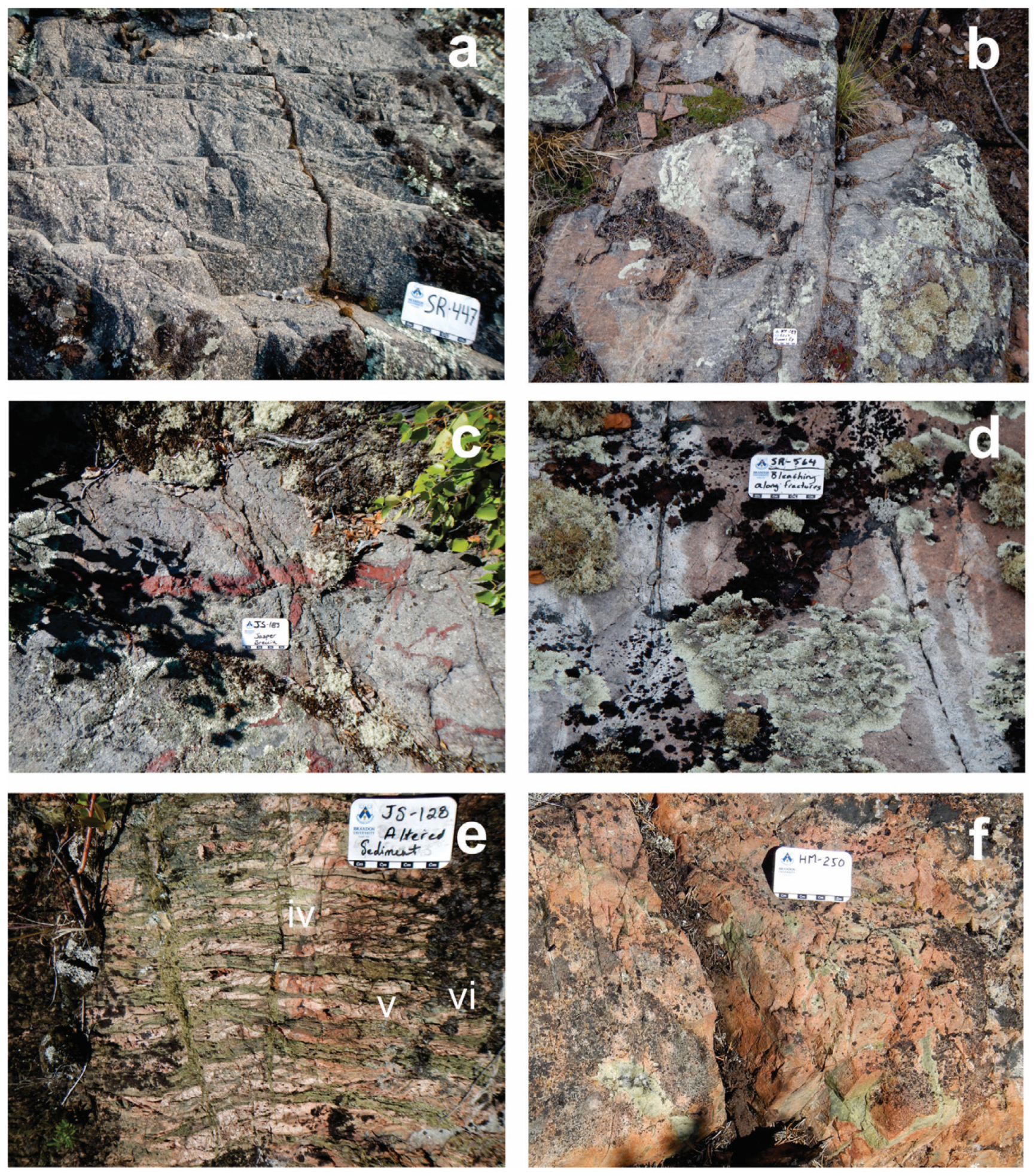
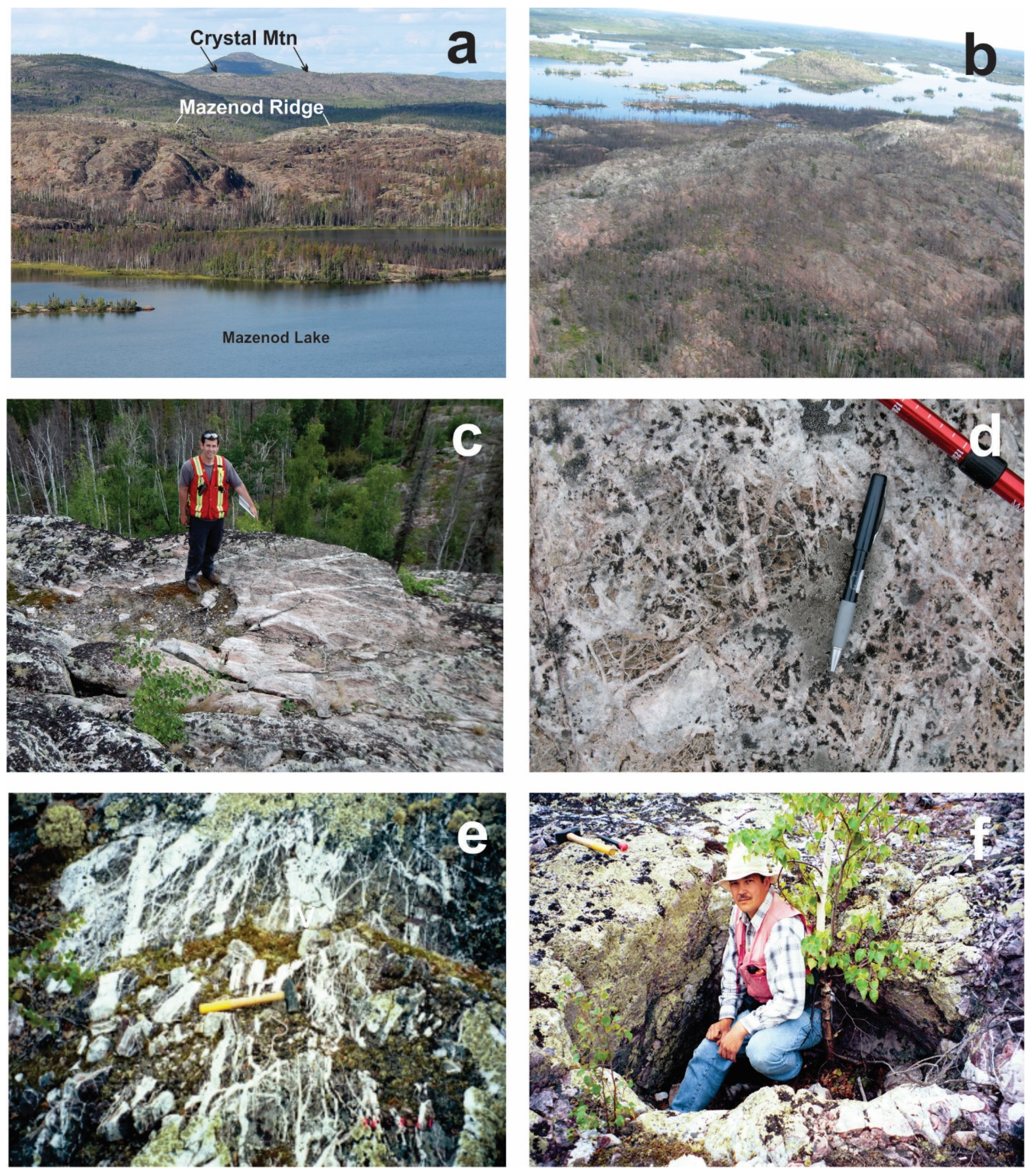
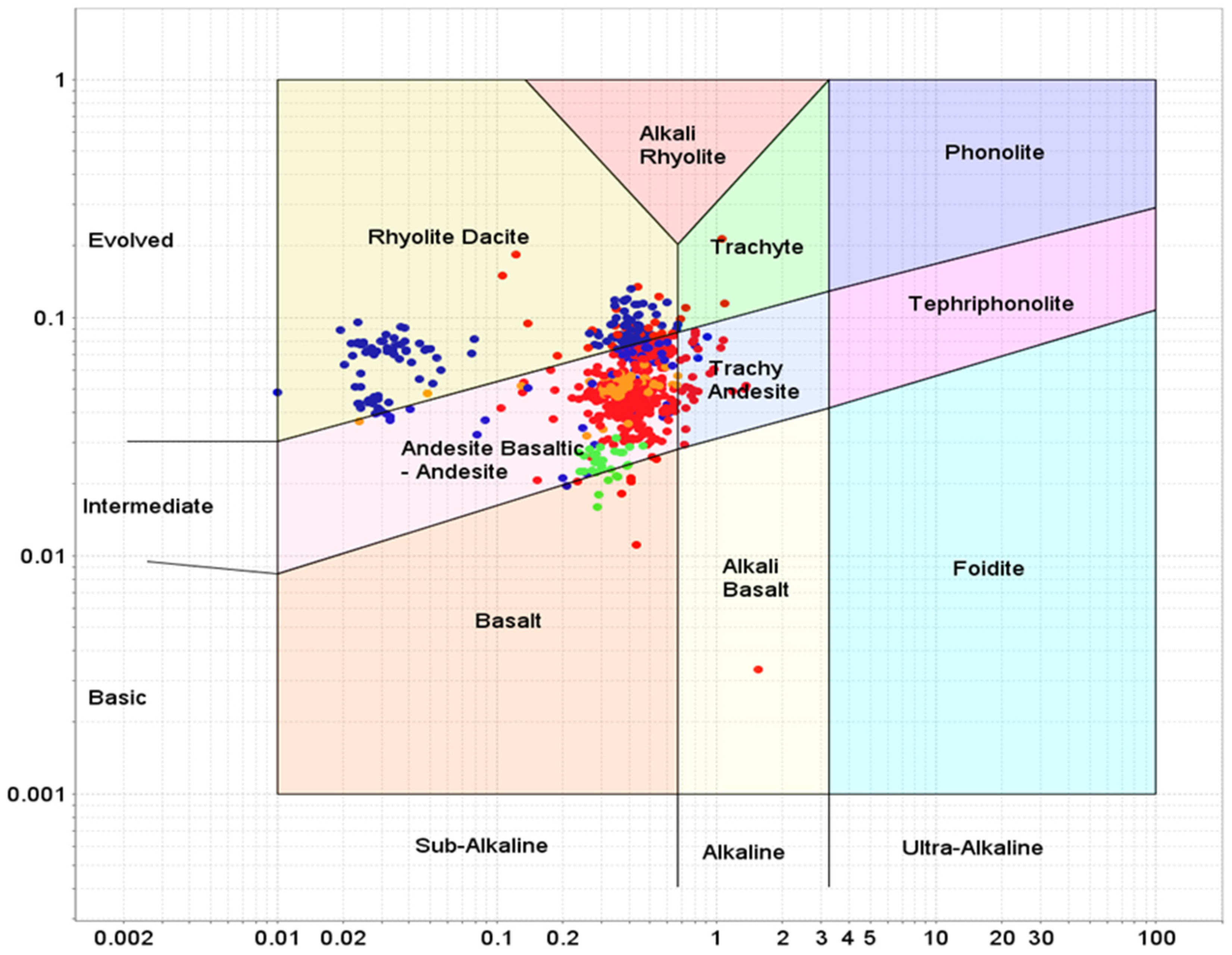
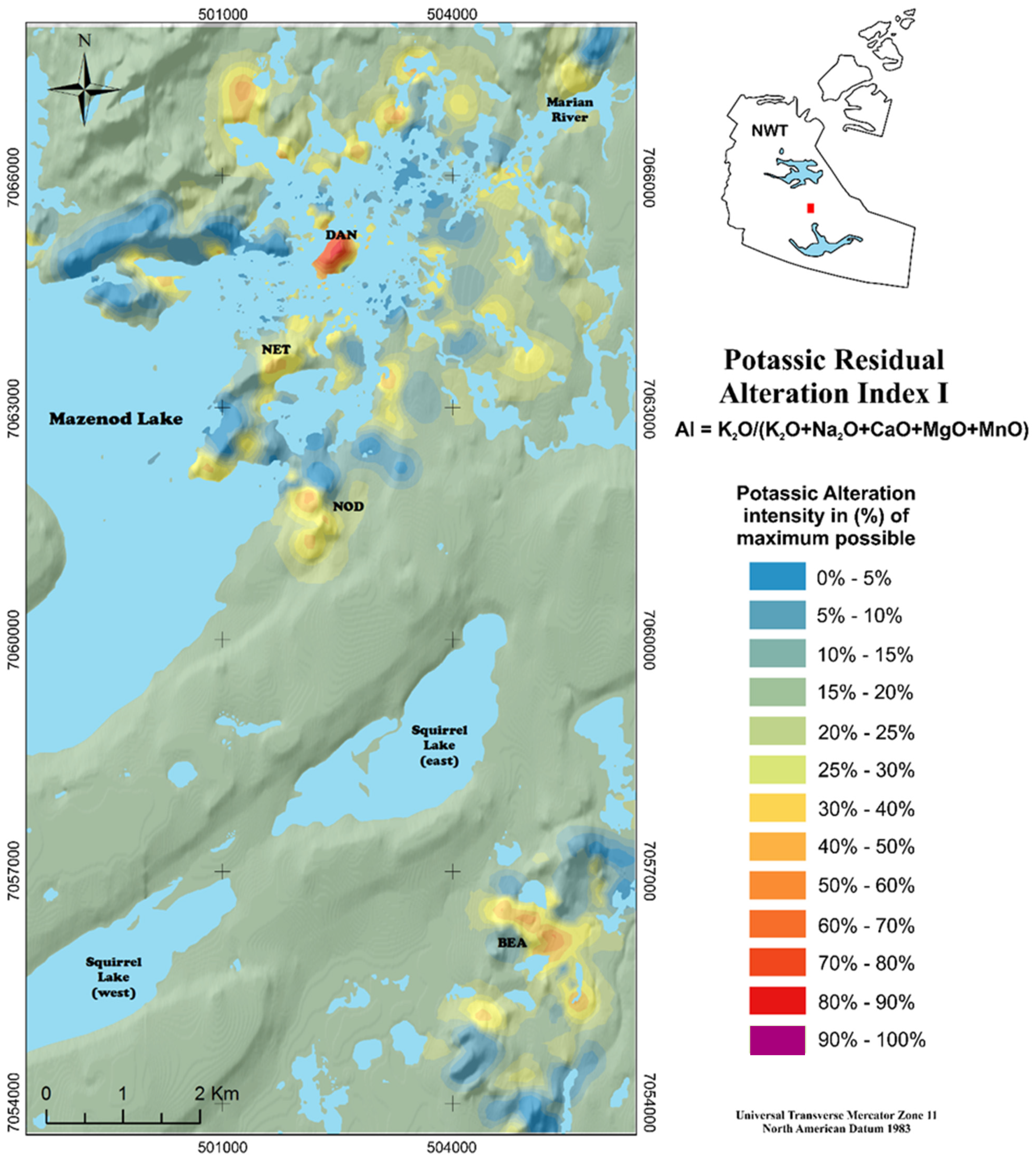

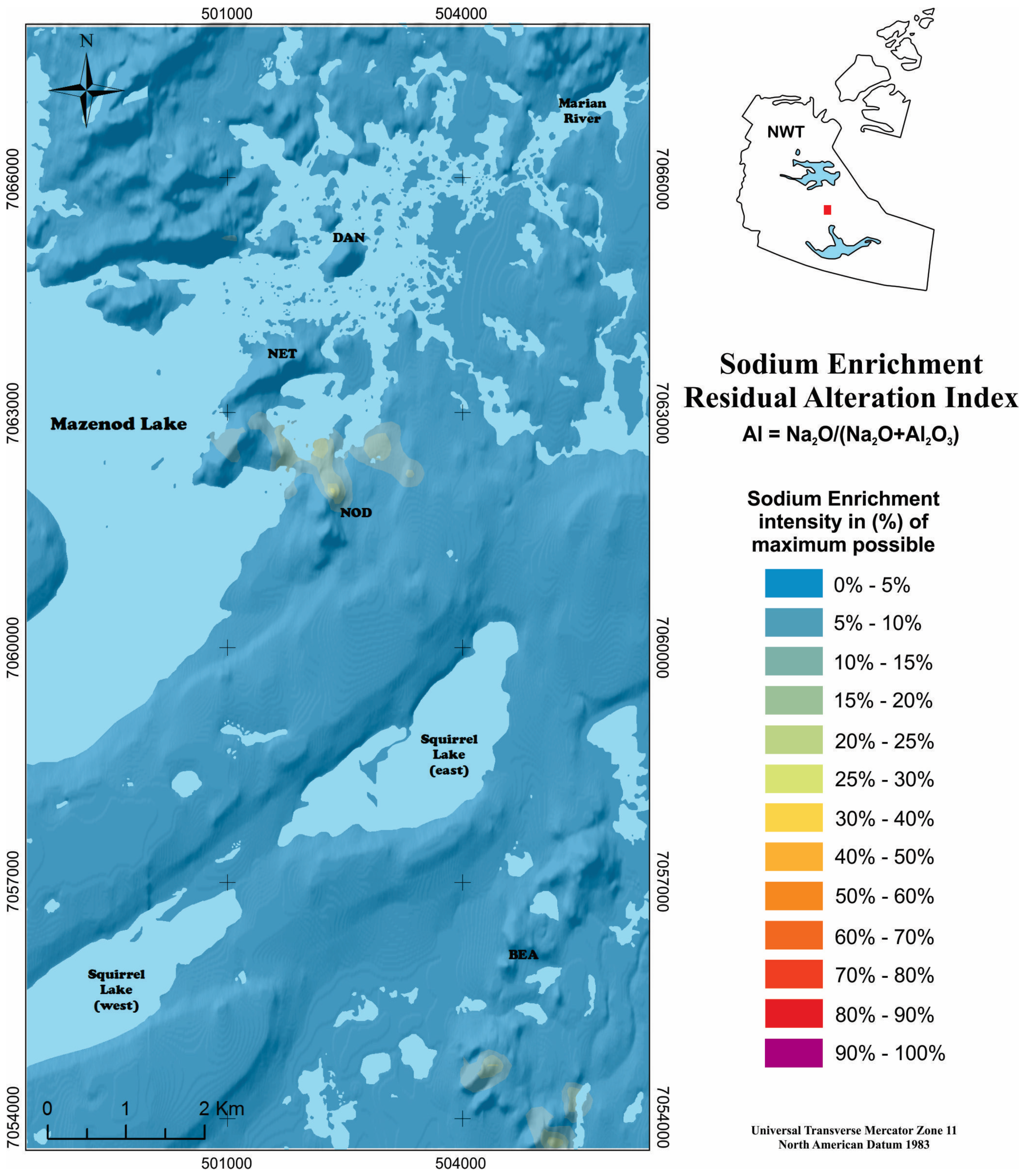
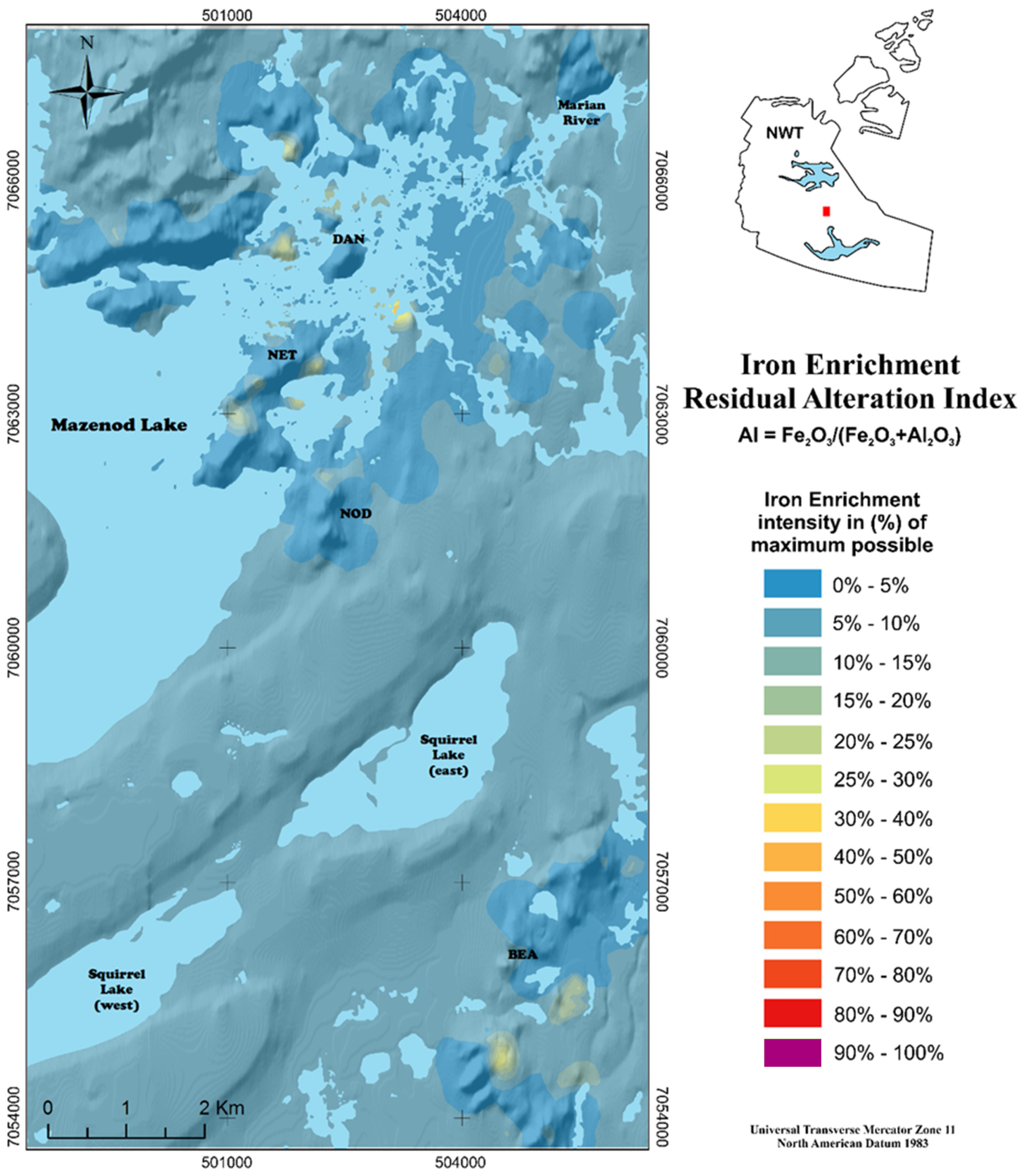
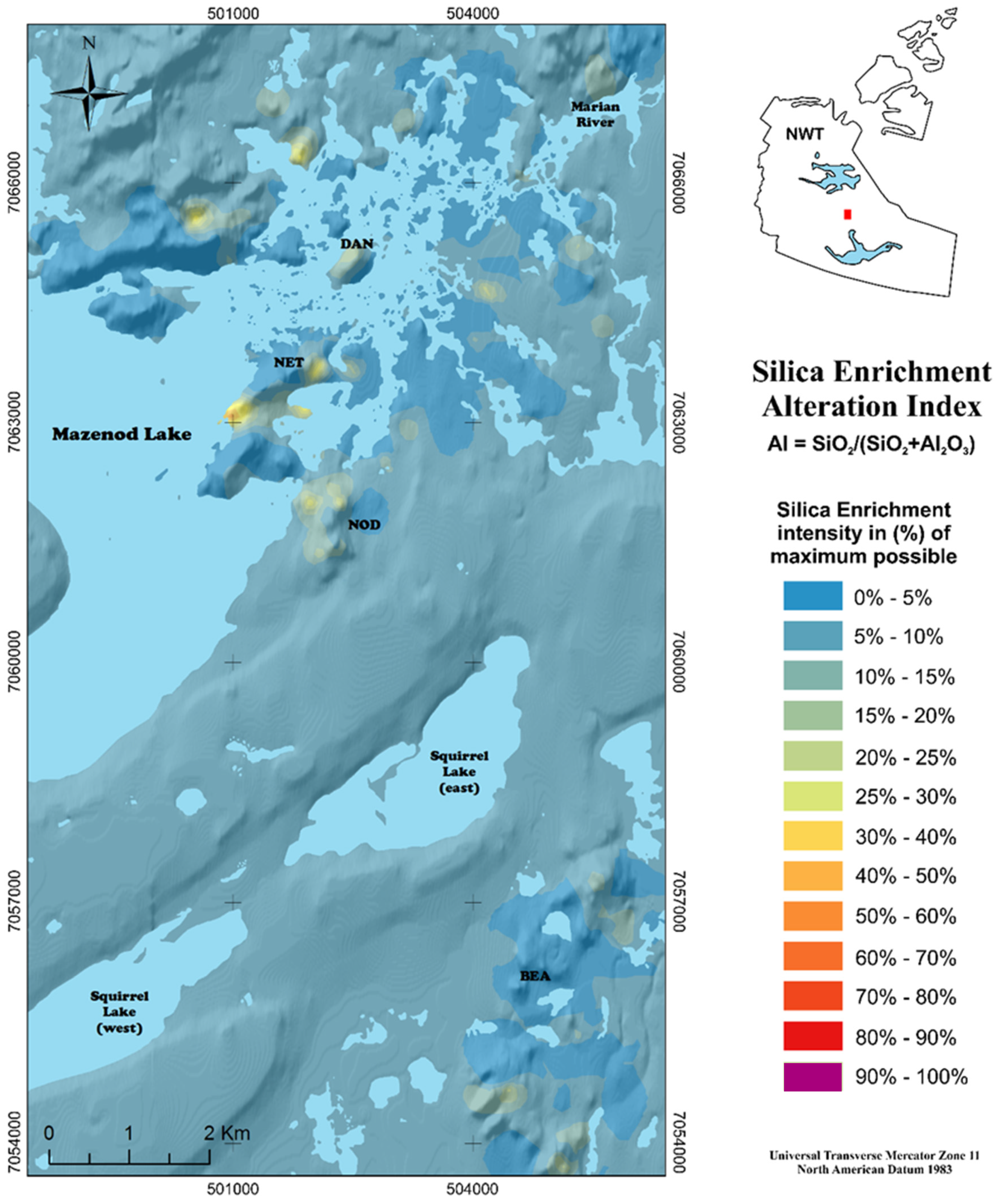
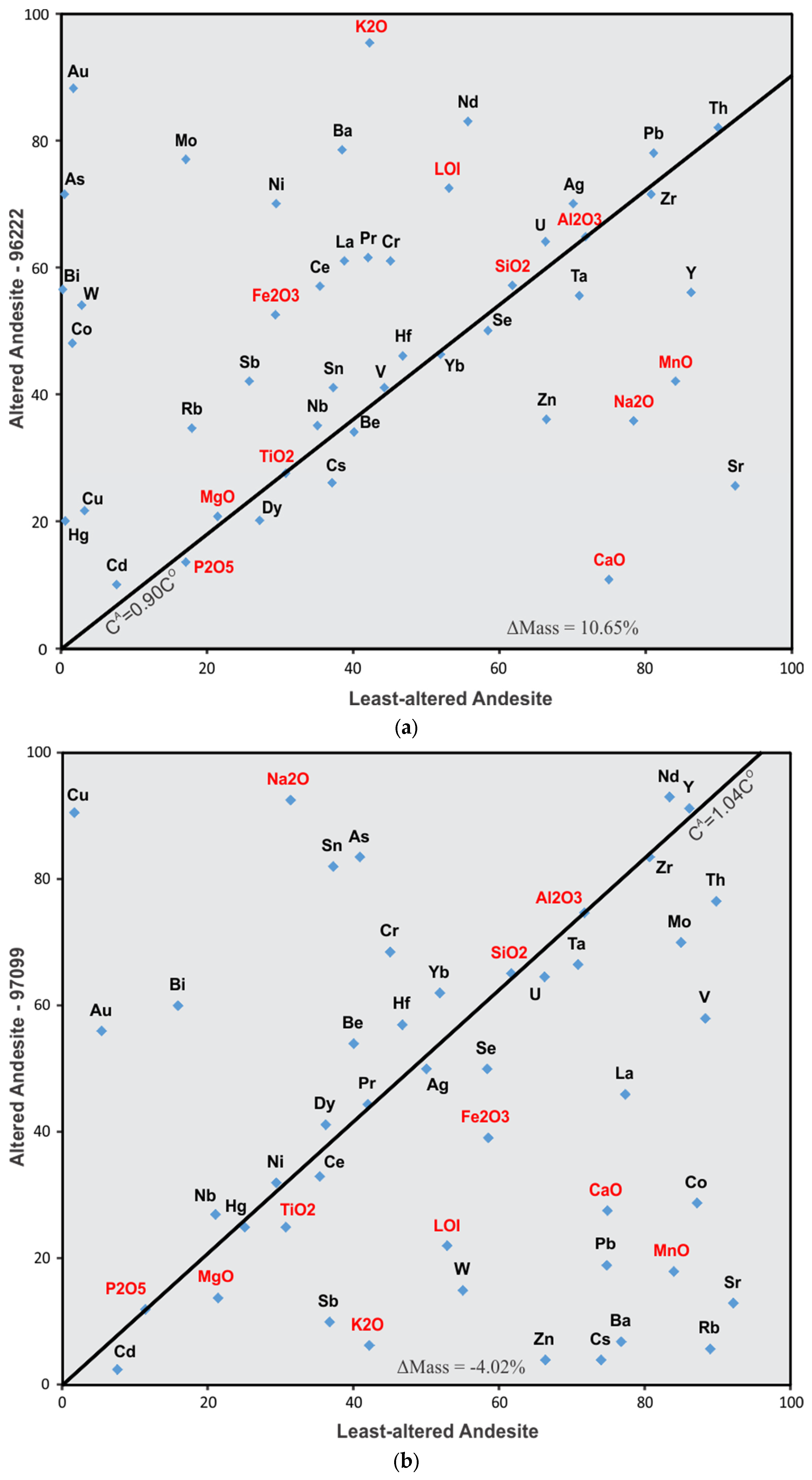
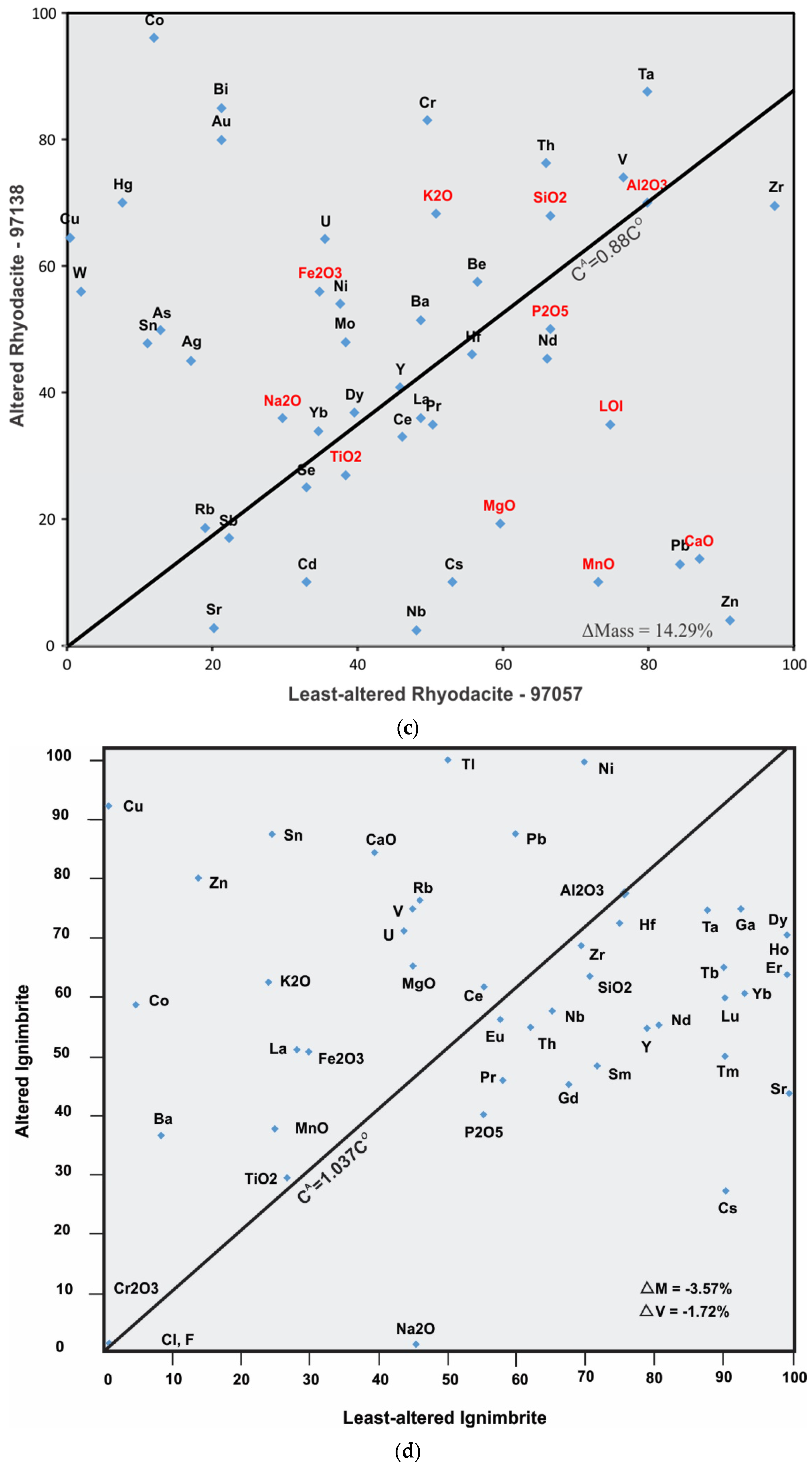
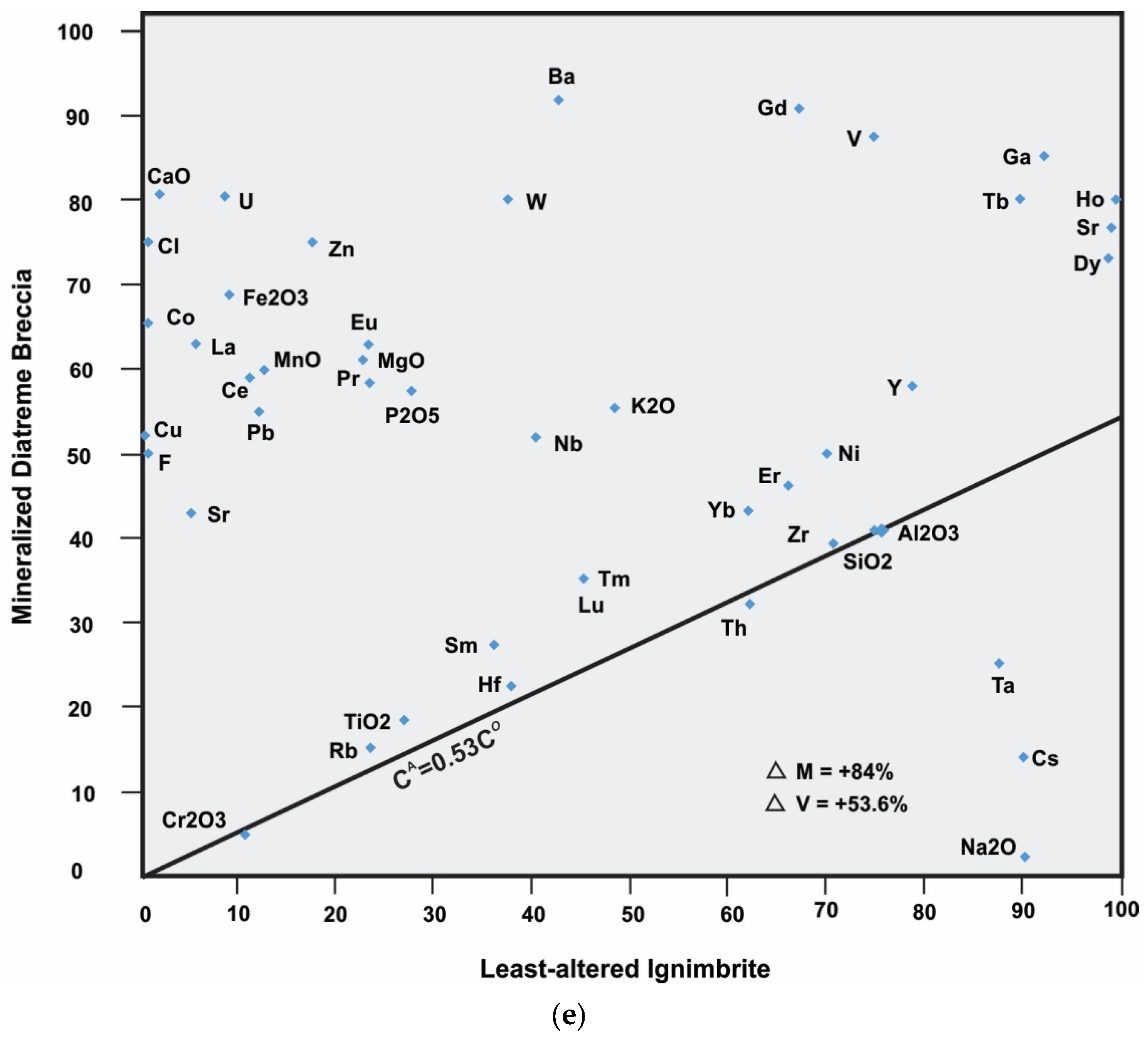
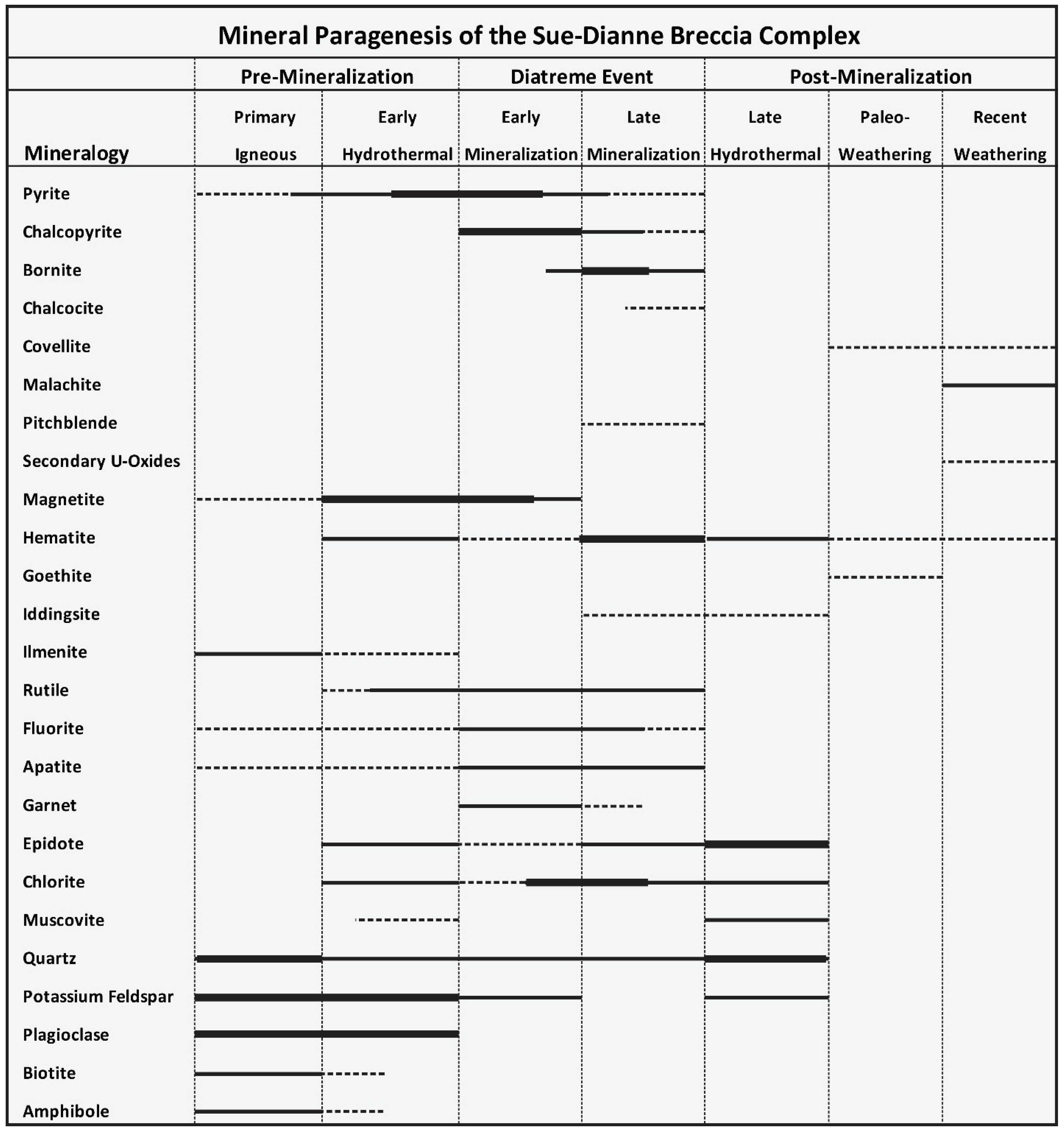
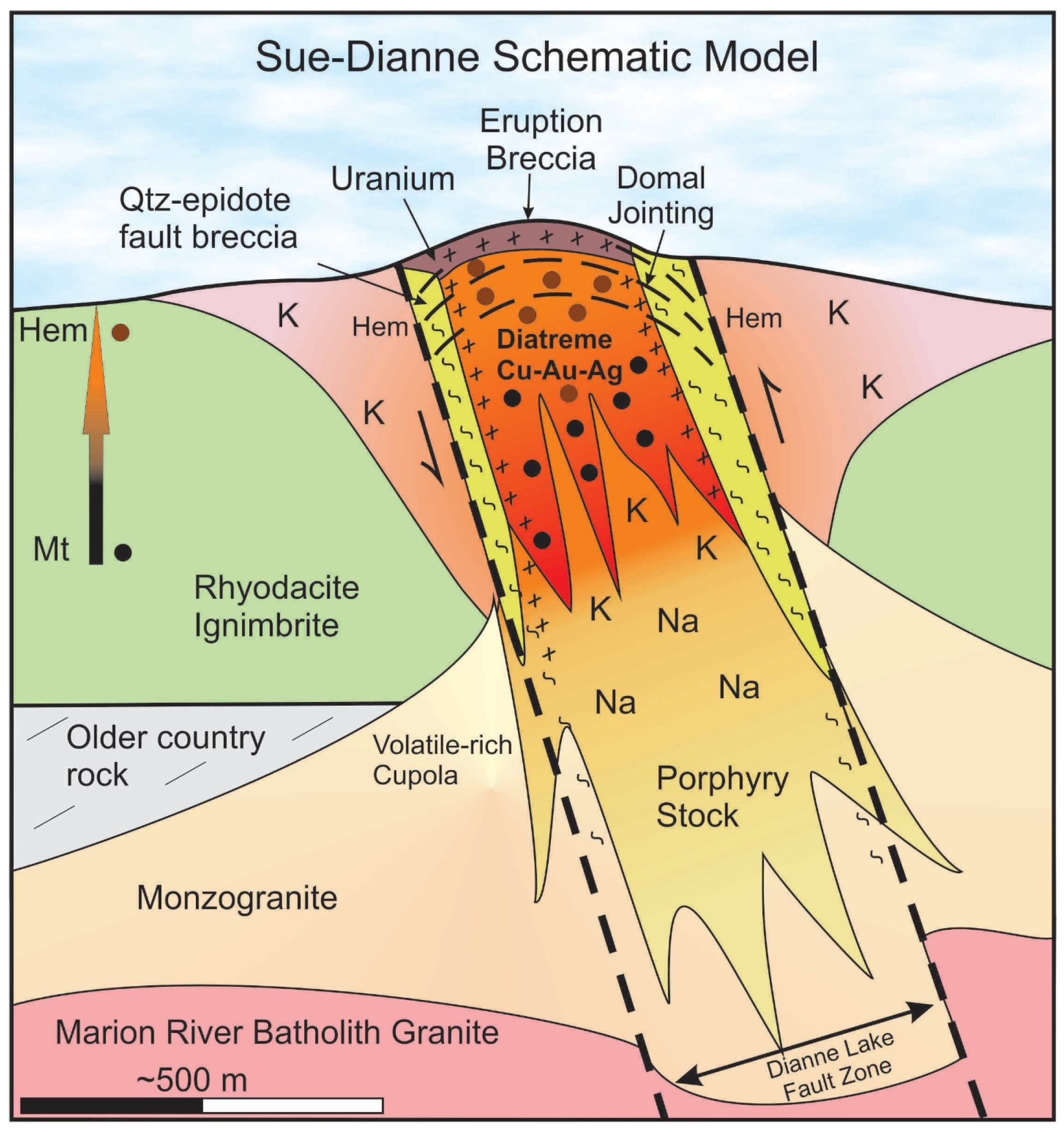

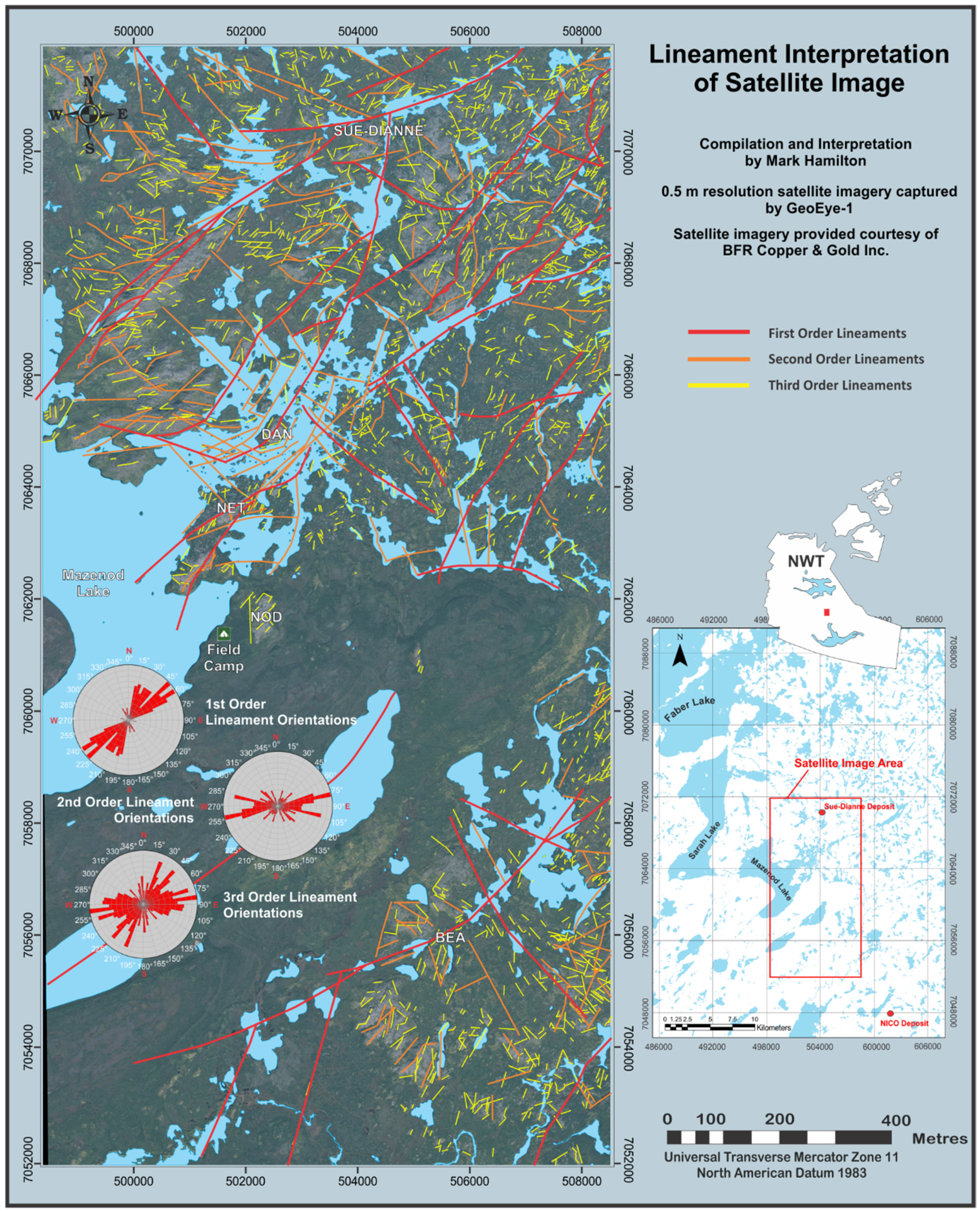
| Alteration Type | Typical Mineral Assemblages | Immobile Elements | Mobile Elements | |||
|---|---|---|---|---|---|---|
| Major Element Oxides | Minor and Trace Elements | |||||
| Enriched | Depleted | Enriched | Depleted | |||
| Sodic2 | Albite ± Magnetite ± Actinolite | Al2O3, TiO2, Ta, Zr, Hf | Na2O | K2O, CaO, MnO | Cr, Sn, Bi, As Au, Cu | Rb, Zn, Cs, Sr, Mo, Pb W, Sb |
| MA | Magnetite ± Actinolite | Al2O3, TiO2, SiO2, Zr, Hf, Tl, Ta, HREEs | Na2O ± Fe2O3 | K2O, MgO, MnO | Sn, As, Cr, Ce | Cs, Zn, Sr, Cd, Be |
| Potassic Mazenod Region | K–feldspar ± Biotite ± Magnetite | Al2O3, Fe2O3, TiO2, SiO2, Zr | K2O ± Fe2O3 | Na2O, CaO, MgO, MnO | Ba, Cr, Rb, Te, Th, U, W, Sn, As, Au, Bi | Be, HREEs, Mo, Nb, Nd, Ni, Pb, Sc, Sr, Zn |
| Potassic Sue–Dianne Deposit halo | Al2O3, TiO2, Zr, Ce, Eu | K2O, CaO, MgO, Fe2O3 | Na2O, P2O5 | Cu, Co, U, Zn, Pb, V, La, Rb, Ba, Tl, Ni | Cs, Sr, Ta, REEs, Y | |
| Tourmaline | Tourmaline ± Quartz | Al2O3, TiO2, Zr, U, Th, Se, Ta, Tl | K2O, SiO2, Fe2O3 | Na2O, CaO, MnO, MgO | Ag, Au, As, Ba, Bi, Co, Cr, Hg, Mo, Rb, Sb, W, Sn | Be, Ce, Cu, Pb, Cs, REEs, Sr, Zn |
| Hematite | Hematite ± Quartz | Al2O3, TiO2, SiO2, Th, Ta | Fe2O3, MgO, MnO, K2O | Na2O, CaO, P2O5 | Hg, Cr, Ga, Ge, Sn, Te, Tl, W, REEs, Ni, Co | Cs, Pb, Sr, Th, Zn |
| Propylitic | Epidote ± Chlorite ± Carbonate ± Quartz | Al2O3, SiO2, Ag, Ga, Hf, Nb, Sc, Te, Th, Tl, Y, Zr | MnO, P2O5 | MgO, Na2O | Bi, REEs, Cu, Sb, Sr, Mo, Sn, W | Au, Ni, Cs, Co |
| Diatreme Sue–Dianne Deposit | Magnetite, Hematite, Chlorite, Garnet, Fluorite, Sulphides | Al2O3, TiO2, SiO2, Th, Zr, Cr, Rb, Hf | Fe2O3, CaO, MgO, K2O, P2O5, MnO | Na2O | Cu, Co, U, Pb, Au, Ag, Zn, V, F, Cl, La, Ce, Eu, Pr, W, Sr, Ba, Nb | Ta, Cs |
| Silicification | Quartz | Al2O3, Hf, Ta, Th, U, W, Zr, REEs | SiO2 ± Fe2O3 | CaO, Na2O, TiO2, P2O5 | Ag, As, Au, Bi, Cu, Hg, Mo, Nb, Nd, Te | Eu, Sr |
| Rock Type | Least Altered Selection | Element Concentrations | ||||||||||||
|---|---|---|---|---|---|---|---|---|---|---|---|---|---|---|
| Al2O3 wt.% | CaO wt.% | Fe2O3 wt.% | MgO wt.% | MnO wt.% | P2O5 wt.% | K2O wt.% | Na2O wt.% | TiO2 wt.% | SiO2 wt.% | LOI wt.% | ||||
| Andesite | Average 1 | 15.93 | 3.74 | 5.85 | 2.13 | 0.14 | 0.11 | 4.21 | 3.13 | 0.61 | 61.67 | 2.67 | ||
| Basaltic Andesite | 9,8156 | 17.3 | 7.45 | 8.82 | 4.25 | 0.1 | 0.08 | 2.3 | 2.82 | 0.68 | 54.2 | 1.6 | ||
| Dacite | 9,8089 | 16.4 | 3.44 | 5.61 | 1.45 | 0.05 | 0.22 | 4.86 | 2.94 | 0.84 | 62.8 | 1.4 | ||
| Rhyodacite | Average 2 | 16 | 2.49 | 3.51 | 1.15 | 0.07 | 0.07 | 5.11 | 3 | 0.43 | 66.7 | 1.5 | ||
| Monzodiorite | 9,7078 | 16.1 | 2.8 | 3.18 | 0.94 | 0.07 | 0.07 | 4.99 | 3.27 | 0.42 | 67.4 | 0.9 | ||
| Monzogranite | Average 3 | 12.3 | 0.19 | 1.2 | 0.21 | 0.02 | 0.01 | 7.48 | 1.65 | 0.1 | 76.25 | 0.55 | ||
| Ag ppm | As ppm | Au ppb | Ba ppm | Be ppm | Bi ppm | Cd ppm | Ce ppm | Co ppm | Cr ppm | Cs ppm | Cu ppm | Dy ppm | ||
| Andesite | Average 1 | <0.1 | 6.8 | 3 | 820 | 2.1 | 0.3 | <0.1 | 77 | 16.6 | 92 | 4.4 | 33.6 | 3.98 |
| Basaltic Andesite | 9,8156 | <0.1 | 4.6 | <2 | 248 | 2.1 | 0.3 | <0.1 | 43 | 20.9 | 175 | 1.4 | 5 | 2.87 |
| Dacite | 9,8089 | 0.2 | 5.5 | <2 | 867 | 2.6 | 0.1 | 0.2 | 106 | 10.1 | 73 | 2.4 | 18.2 | 5.47 |
| Rhyodacite | Average 2 | 0.35 | 6.67 | 4 | 979 | 2.3 | 0.43 | 0.2 | 93 | 6.2 | 99.7 | 2.1 | 18.23 | 3.99 |
| Monzodiorite | 9,7078 | <0.1 | 4.8 | <2 | 908 | 2.4 | 0.3 | 0.2 | 88 | 5.2 | 129 | 1.6 | 9.6 | 3.78 |
| Monzogranite | Average 3 | 0.41 | 0.88 | 1 | 235.5 | 2.7 | 0.23 | <0.1 | 61 | 1.9 | 160.3 | 1.35 | 9.23 | 3.79 |
| Er ppm | Eu ppm | Ga ppm | Gd ppm | Ge ppm | Hf ppm | Hg ppm | Ho ppm | La ppm | Lu ppm | Mo ppm | Nb ppm | Nd ppm | ||
| Andesite | Average 1 | 2.12 | 1.2 | 18.8 | 4.4 | 1.4 | 4.1 | <0.1 | 0.99 | 39 | 0.3 | 1.5 | 9 | 29.9 |
| Basaltic Andesite | 9,8156 | 1.48 | 0.94 | 15.3 | 3.19 | 1.4 | 3.1 | <0.1 | 0.66 | 21 | 0.2 | 1.3 | 5 | 19.2 |
| Dacite | 9,8089 | 2.66 | 1.76 | 19 | 6.17 | 1.5 | 7.6 | <0.1 | 1.31 | 50 | 0.4 | 2.3 | 10 | 41 |
| Rhyodacite | Average 2 | 2.12 | 1.35 | 17.73 | 4.53 | 1.33 | 5.60 | 0.23 | 0.95 | 49 | 0.37 | 1.9 | 9.7 | 33.17 |
| Monzodiorite | 9,7078 | 2.07 | 1.25 | 15.5 | 4.35 | 1.2 | 5.9 | <0.1 | 0.88 | 46 | 0.4 | 1.5 | 10 | 31.4 |
| Monzogranite | Average 3 | 2.18 | 0.36 | 13.03 | 3.55 | 1.38 | 3.75 | <0.1 | 0.91 | 29.25 | 0.43 | 1 | 21.5 | 21.98 |
| Ni ppm | Pb ppm | Pr ppm | Rb ppm | Sb ppm | Sc ppm | Se ppm | Sm ppm | Sn ppm | Sr ppm | Ta ppm | Tb ppm | Te ppm | ||
| Andesite | Average 1 | 13 | 12.3 | 9.06 | 209 | 4 | 13 | <1 | 5.28 | <0.1 | 195 | 1.82 | 0.7 | <0.1 |
| Basaltic Andesite | 9,8156 | 39 | 5.7 | 5.13 | 146 | 1 | 23 | <1 | 3.73 | 6.3 | 203 | 0.75 | 0.47 | <0.1 |
| Dacite | 9,8089 | 10 | 17.2 | 12.1 | 176 | 5 | 11 | <1 | 7.29 | 2.3 | 231 | 1.61 | 1 | 0.1 |
| Rhyodacite | Average 2 | 19 | 21.13 | 10.14 | 194 | 1.3 | 7 | 0.67 | 5.26 | 1.28 | 206 | 1.6 | 0.7 | <0.1 |
| Monzodiorite | 9,7078 | 39 | 1.03 | 0.74 | <0.1 | 9.44 | 18.4 | 9.89 | 173 | 1 | 7 | <1 | 5.26 | 9.3 |
| Monzogranite | Average 3 | 7.75 | 10.33 | 6.92 | 298 | 0.75 | 1.25 | 0.5 | 4.19 | 0.86 | 38.75 | 4.49 | 0.61 | 0.06 |
| Th ppm | Tl ppm | Tm ppm | U ppm | V ppm | W ppm | Y ppm | Yb ppm | Zn ppm | Zr ppm | |||||
| Andesite | Average 1 | 21.4 | <0.01 | 0.38 | 7.13 | 92 | 5 | 23.7 | 2.3 | 117 | 153 | |||
| Basaltic Andesite | 9,8156 | 9.48 | <0.01 | 0.24 | 2.12 | 127 | 4 | 17.9 | 1.53 | 28 | 101 | |||
| Dacite | 9,8089 | 21.8 | <0.01 | 0.51 | 6.69 | 57 | 6 | 29.7 | 2.8 | 42 | 257 | |||
| Rhyodacite | Average 2 | 22.03 | <0.01 | 0.39 | 5.98 | 38.3 | 24 | 23.1 | 2.33 | 46 | 195 | |||
| Monzodiorite | 9,7078 | 21.9 | <0.01 | 0.36 | 6.22 | 34 | 7 | 21.9 | 2.28 | 49 | 167 | |||
| Monzogranite | Average 3 | 43.83 | 0.01 | 0.43 | 11.62 | 3.75 | 2.75 | 23.28 | 2.84 | 10 | 67 | |||
Disclaimer/Publisher’s Note: The statements, opinions and data contained in all publications are solely those of the individual author(s) and contributor(s) and not of MDPI and/or the editor(s). MDPI and/or the editor(s) disclaim responsibility for any injury to people or property resulting from any ideas, methods, instructions or products referred to in the content. |
© 2025 by the authors. Licensee MDPI, Basel, Switzerland. This article is an open access article distributed under the terms and conditions of the Creative Commons Attribution (CC BY) license (https://creativecommons.org/licenses/by/4.0/).
Share and Cite
Mumin, A.H.; Hamilton, M. The Mazenod–Sue–Dianne IOCG District of the Great Bear Magmatic Zone Northwest Territories, Canada. Minerals 2025, 15, 726. https://doi.org/10.3390/min15070726
Mumin AH, Hamilton M. The Mazenod–Sue–Dianne IOCG District of the Great Bear Magmatic Zone Northwest Territories, Canada. Minerals. 2025; 15(7):726. https://doi.org/10.3390/min15070726
Chicago/Turabian StyleMumin, A. Hamid, and Mark Hamilton. 2025. "The Mazenod–Sue–Dianne IOCG District of the Great Bear Magmatic Zone Northwest Territories, Canada" Minerals 15, no. 7: 726. https://doi.org/10.3390/min15070726
APA StyleMumin, A. H., & Hamilton, M. (2025). The Mazenod–Sue–Dianne IOCG District of the Great Bear Magmatic Zone Northwest Territories, Canada. Minerals, 15(7), 726. https://doi.org/10.3390/min15070726





